Life and knowLedge at the center of science

•
•
•
28
50
52
54
56
62
64


•
•
•
28
50
52
54
56
62
64
Collective intelligence is created when people work together to manage a large amount of information and ideas to address a social challenge. It’s not something new. Collective intelligence was behind the first Oxford dictionary in the 19th century when thousands of volunteers contributed by sending words and their etymologies to the editors.
Another interesting example occurred in the early 20th century when statistician Francis Galton realized that at
livestock fairs, it was hard for an individual to accurately guess the weight of a cow. However, by aggregating the data from all the participants in the contest, the average of the answers varied only half a kilogram from the actual weight of the animal. Other examples are the Human Genome, Wikipedia, etc. As a collective, we can consistently achieve more than the sum of the parts.
The same applies to the social communication of science. We face global problems such as climate change, where decisions based on scientific evidence are crucial. However, communication between the public and scientific per -
sonnel is influenced by social networks, which prioritize emotional content over factual information, and by misinformation campaigns that proliferate on these platforms. Faced with this, it’s okay for individuals to disseminate information. But it’s not enough.
At Miguel Hernández University of Elche (UMH), we believe the key to genuinely effective social communication of science is to harness our potential as a collective. That’s why we design communication strategies that involve the entire university community and leverage the strengths of our collective intelligence. This way, we can convey that
the data from the scientific process are not opinions but facts. Together, we contribute a diverse view of science, focusing on many social problems and opportunities for improvement for the common good. Together, we foster trust in science.
From the Scientific Culture and Innovation Unit at UMH Sapiens, we see collective intelligence as the engine of change. Therefore, it is our framework when presenting this annual recap of research news’ Science for Sapiens 2024’.
Scientific Culture and Innovation Unit, UMH Sapiens.

A
The dengue virus is already an endemic disease in Spain and it is expected that cases of infection will increase due to periodic floods that favour the spread of its vector – the tiger mosquito –. A study by the University Miguel Hernández of Elche (UMH), published in the journal Biochimica Biophysica Acta Biomembranes, has shown where the virus can interact with human cells and, therefore, where drugs should be directed to prevent infection. This finding could be key to avoiding other diseases caused by similar viruses such as Zika and yellow fever.
As Professor of Biochemistry and Molecular Biology at the UMH José Villalaín – leader of the study – explains, flaviviruses, such as dengue, Zika, West Nile virus or yellow fever, infect human cells by a process called endocytosis. They fuse their membrane with the cell wall depending on the acidity they detect. Therefore, knowing this fusion mechanism is key to obtaining antiviral drugs that prevent infection. Since the interaction between viruses and healthy cells occurs through very complex proteins, in order to understand the process it is necessary to simulate by computer how the chemical interaction between their molecules occurs.
Researcher of the Institute for Development, Research and Innovation in Health Biotechnologies of the University Miguel Hernández (IDiBE) José Villalaín has applied virtual analysis to study one of the most important health threats that Spain has in general and the Valencian Community in particular: flavivirus infections. Specifically, the dengue virus, which is already endemic in our country, since autochthonous cases have been detected. According to the researcher, it is expected that more and more cases will occur due to high temperatures and periodic floods that favour the spread of the Aedes aegypti or Aedes albopictus mosquitoes, whose bite can transmit the disease.
The new UMH study has shown that a specific sequence of the protein E of the dengue virus is responsible for both the protein-protein and protein-membrane interaction, fundamental in the process of protein activation and the consequent fusion of viral and cellular membranes. Since membrane fusion is the first and most important step in dengue virus infection, this discovery is essential to finding an infection inhibitor.
This study has been carried out using molecular dynamics, a process of “virtual simulation” of the interaction between proteins that requires so much computing power that a set of computers must be used to carry out the experiment. In these simulations, you can see how each atom that makes up the proteins of the virus behaves, so that both the interaction between molecules and what happens inside them can be studied in detail. For this type of research, the UMH has a scientific computing cluster, a group of computers linked with a high-speed network, managed by the Technology Innovation and Planning Service.
Previous publications by Professor Villalaín proved that the protein E of the dengue virus, responsible for the entry of the virus into the host cell, has three binding points to biological membranes. “Finding and defining the therapeutic
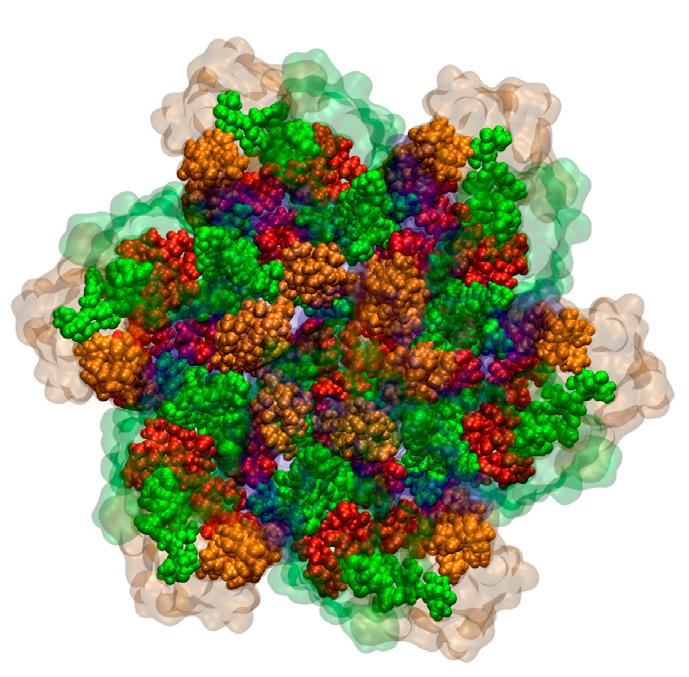
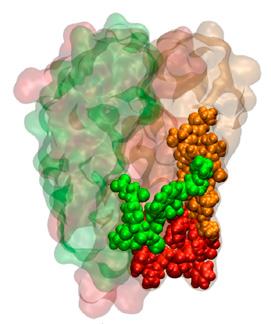
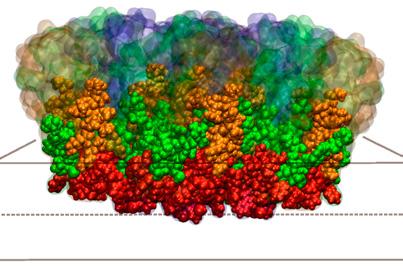
This finding could be key to avoiding other diseases caused by similar viruses such as Zika and yellowfever
targets responsible for viral infections is essential to be able to design antiviral molecules that prevent infections of this type of virus, which are increasingly and unfortunately becoming more recurrent and affect a large part of the population”, explains the researcher of the UMH. The additional importance of the new research is that this segment, also found in other similar types of viruses, could help find antiviral molecules that would also be effective against dengue-like virus infections, such as Zika or yellow fever.
It shows that one of the segments of the protein E of the dengue virus, besides functioning as a pH sensor, that is, being able to detect the entry of the virus into the late endosome, binds to the biomembrane of the cell with a high affinity and great specificity, which makes it a fundamental therapeutic target with which to attack the virus.
Villalaín, J. (2023). Phospholipid binding of the dengue virus envelope E protein segment containing the conserved His residue. Biochimica et Biophysica Acta (BBA)-Biomembranes, 184198.Mediterranean diet prevents and reverses non-alcoholic fatty liver, UMH study finds
While a poor diet, such as processed products, promotes non-alcoholic hepatic steatosis, a healthy diet prevents fat retention in the liver. A team of researchers from Spain, Israel and Italy have published in the British Medical Journal a recommendation based on scientific evidence that insists on giving more social importance to this disease, which affects more than 30% of the population and is linked to obesity, type 2 diabetes, metabolic syndrome, dyslipidaemia and hypertension. Professor of Physiology at the Miguel Hernández University of Elche (UMH) Bernat Soria, co-author of the study, voluntarily underwent a liver biopsy to show that non-alcoholic fatty liver disease is reversible if you have healthy eating habits and physical activity.
The non-alcoholic fatty liver disease (NAFLD) involves a buildup of fat in liver cells in individuals who take little or no alcohol. It has become a constantly growing Public Health problem, closely related to Obesity, type 2 Diabetes and Metabolic Syndrom. According to the study published in the British Medical Journal, more than 30% of the world’s adult population suffers from fatty liver, with an estimated annual growth of 0.7%. This disease, which can progress to liver fibrosis in 10-15% of patients, represents one of the main risk factors for developing liver cancer.
“The scientific evidence collected so far,” says Bernat Soria, a researcher at the UMH Bioengineering Institute, “shows that people’s diet plays a crucial role in this disease.” A poor diet, with too many saturated fatty acids and sugars, typical of processed products and sugary drinks, contributes to liver damage and adipose-tissue disorders, systemic inflammation and imbalance of the gut microbiota. On the other hand, diets such as the Mediterranean – based on vegetables, fruit, legumes, nuts, whole grains and fish – can reduce the risk of fatty liver disease and promote cardiometabolic health. Specifically, a 10% reduction in weight along with lifestyle changes, such as daily walks, decreases fat accumulation in the liver, inflammation and fibrosis. “What’s more, a healthy lifestyle not only prevents NAFLD but can reverse it”, emphasizes the UMH Professor, who suffers from this disease.
In addition to being co-author of the publication, Bernat Soria, researcher at the Institute for Health and Biomedical Research of Alicante (ISABIAL), provided the view from the side of the patient with fatty liver. He underwent a biopsy to show that, after a period of Mediterranean diet and physical activity, the fatty liver can heal. This is not the first time a researcher undergoes an intervention to test the validity of a hypothesis. In 1956, the German physician Werner Forssmann received the Nobel Prize for his pioneering technique for the catheterisation of the human heart, which he performed for the first time and successfully on himself.
A previous study by Professor Soria had already proven the beneficial effects of extra virgin olive oil on the action of insulin (Mol Nutrition Food Res 2016; scientific Reports 2019) and more recently the beneficial effects of Cellular


Diets such as the Mediterranean – based on vegetables, fruit, legumes, nuts, whole grains and fish–can reduce the risk of fatty liver disease and promote cardiometabolic health
Therapy to delay the onset of type 1 diabetes (Frontiers Cell Dev Biol 2023). The anti-inflammatory and regenerative effects of this Cellular Therapy helped to decrease mortality due to COVID-19 (The Lancet-eClinical Medicine 2020) and to the recovery of cognitive capacity in mice (Frontiers in Neuroscience 2019).
The study, led by researcher from CIBEREHD and the Virgen del Rocío University Hospital in Seville Manuel Romero Gómez, advocates a comprehensive approach that involves the whole society through awareness, education and policy change. Preventing obesity and fatty liver, the researchers say, involves promoting a healthy lifestyle from an early age, active participation of health professionals, regulating unhealthy food advertising, and implementing government policies, such as taxes on sugary drinks and food reformulation.
Eating ultra-processed foods like pizza, soft drinks, and pastries increases body mass index and blood pressure. This is one of the conclusions of the study led by researcher Sandra González Palacios, member of Professor Jesús Vioque’s group of the Unit for Nutrition Epidemiology of the University Miguel Hernández of Elche (UMH).
The work, published in the journal Atherosclerosis, evaluates the impact on cardiovascular health of taking ultra-processed foods in 5,373 participants over 55 years of age with metabolic syndrome, belonging to the PREDIMED-Plus intervention project. Professor Jesús Vioque, who leads this project at the UMH, explains that PREDIMED-Plus is a multicentre study to evaluate the effect of an intensive intervention on lifestyle, based on a hypocaloric Mediterranean diet, physical activity and behavioural treatment on the risk of cardiovascular events.
According to researcher Sandra González, cardiovascular diseases are the largest cause of premature mortality in the world. “However”, the expert explains, “our diet is a modifiable factor that can help prevent the risk of developing these diseases”. Therefore, it is interesting to evaluate the impact of foods with a lot of calories and little nutritional value, such as ultra-processed foods, whose consumption is being linked to the risk of suffering cardiometabolic diseases by more and more studies. “These foods provide free sugars, saturated fats and also showed a low content of other nutrients such as fibers, proteins, minerals and vitamins”, reports the study carried out at the UMH.
At the beginning of the study, participants took about 160 grams per day of ultra-processed foods on average. A year later, consumption dropped significantly to just over 100 grams a day. In addition, after a year of participation, people with higher intakes of ultra-processed foods had higher body weight, waist circumference and diastolic tension, as well as higher blood levels of fasting glucose and triglycerides.
Study participants who ate more ultra-processed foods such as pastries, soft drinks, fried snacks, etc. are more likely to have diabetes and high cholesterol. Therefore, the authors conclude that a higher consumption of ultra-processed foods is associated with a worse evolution of cardiovascular risk factors, after a year of follow-up, in adults with metabolic syndrome.

Our diet is a modifiable factor that can help prevent the risk of developing these diseases
rofessor of Psychology at the University Miguel Hernández (UMH) of Elche Yolanda Quiles has been one of the people responsible for carrying out the Spanish adaptation of the innovative ECHOMANTRA therapy. This therapy, born in London (United Kingdom), is focused on patients with eating disorders and their families. Although it is still in the research phase, it is starting to give positive results.
Yaiza is a fifteen-year-old teenager, a young promise of swimming and one of the pillars of her family. But one day her knee was injured. At that time, COVID-19 was spreading around the world. Used to constant physical activity, she was worried about putting on weight as she could not practise so much sport. Therefore, she started a vegetarian diet, ate less and less and increased physical exercise at home. She began to lose a lot of weight, but she linked her thinness to muscle atrophy in the injured leg. On the other hand, her mother, María, felt guilty and uncertain about her daughter’s situation. Also, about what the problem really was.
After seeing different specialists, the Child and Adolescent Mental Health Unit diagnosed Yaiza of restrictive anorexia nervosa, according to the criteria of the Diagnostic and Statistical Manual of Mental Disorders (DSM-V). The health staff proposed hospitalisation, but their parents opted for a day centre specialised in eating disorders. It was there that the ECHOMANTRA project, a recent therapy based on intervention in patients with eating disorders – such as anorexia or bulimia – and also in their immediate family environment which is giving good results, was launched.
This new therapy was born after the fusion of the ECHO and MANTRA therapies at King’s College in London. Yolanda Quiles, director of the Group for Research and Intervention on Eating Disorders at the University Miguel Hernández (UMH) in Elche, has been in charge of adapting the ECHOMANTRA programme to the Spanish population. It is currently under research and being applied as a complementary treatment to the usual therapy. From the Centre for Emotional and Food Recovery (CREA Centre), a spin-off of the UMH led by professors María José Quiles and Yolanda Quiles, this therapy has been applied to about 80 families. Yaiza and María, despite being pseudonyms, are a real example of one of these families.
The eight sessions of treatment
Once Yaiza entered the day centre, her case was proposed for the ECHOMANTRA programme. The project is based on helping relatives and patients who have an eating disorder. Over the course of six months, mother and daughter have held eight individual sessions with ECHO and MANTRA contents. ECHO is the family-focused part of experienced caregivers who help others. The MANTRA (Maudsley Model of Anorexia Nervosa Treatment for Adults) is the part related to patients.

It is currently under research and being applied as a complementary treatment to the usual therapy
To perform the therapy, mother and daughter have received a Patient and Caregiver Notebook. In this notebook, divided into eight parts, one for each session, there are exercises for reflection that Yaiza and María must work on before each meeting. The main goals of this therapy are to make it easier for Yaiza to continue her treatment at home after attending the day centre and to teach her and her mother to cope with the situations that anorexia nervosa can cause.
The ECHO treatment has sought to reduce behaviours or comments that María could make and that, involuntarily, potentiate or provoke behaviours that maintain Yaiza’s problem. Psychologist Yolanda Quiles gives us the following example: “Sometimes, patients ask questions related to the calories of food, what makes them put on more weight and what less, etc. And family members, without realising, answer those questions. Sometimes, the simple fact of continuing the conversation causes the disease to grow unconsciously. This is the way it is present. Then, throughout the therapy parents are taught to detect those situations in which, in a totally involuntary way, they give space to the disease. Once they are aware of those actions, they are offered tools to act in a more appropriate way”.

The therapy has also sought to increase María’s confidence in herself and her decisions regarding the care of her daughter. Another objective of this part of the intervention has been to reduce the emotional overinvolvement of family members and the impact that the disease can have on them. For example, María, at the beginning of the therapy, did not understand what was happening to her daughter, it affected her very much to see her daughter irritable or avoiding eating with them. And during the therapy she understood that it was not a problem that she had caused or that her daughter did not want to be with her, but that she was sick.
The patient-focused part of the MANTRA has been centred on motivating her to change her behaviour to one that is healthy for herself. At the same time, it has sought to reduce the possibility of relapses to improve Yaiza’s quality of life. In addition, this part of the treatment attempts to reduce Yaiza’s perfectionist behaviours. This last aspect is a personality trait that, according to Quiles, is a risk factor in terms of eating disorders. A person with anorexia or bulimia can be very self-demanding. One of the goals of this part of the MANTRA therapy is to provide Yaiza with sufficient tools to make decisions and solve problems on her own.
The treatment results have shown the efficacy of ECHOMANTRA for patients and their families. All aspects that have been sought to improve throughout the therapy have been evaluated with questionnaires, which have been filled in by mother and daughter since their admission to ECHOMANTRA, as well as with their follow-up by the professionals who assist them.
The results show positive and sustained progress throughout the process. For example, Yaiza no longer overexercises three days a week, but one. Her body mass index, despite not reaching the recommended 18.5 kg/m2, has increased from 14.50 kg/ m2 to 16.90 kg/m2, indicating positive progress. In addition, it has been achieved that the patient increased her motivation to change. That is, the change toward her improvement was voluntary and active on her part. This change of attitude has been evaluated with two questions: To what extent is it important for you to change? How much confidence do you have in your ability to change? The answers to these questions, with a score out of 10, have improved after the intervention compared to the beginnings. In fact, all the parameters evaluated show improvements, except her perfectionism.
The director of the CREA Centre, Yolanda Quiles, explains that perfectionism is a risk factor depending on how it is oriented. “The problem is when we orient it toward unattainable goals that go against our health”, explains the professor of psychology at the UMH, “There are many people who are very perfectionist and that is not why they develop an eating disorder”, she adds.
Perfectionism implies that people impose on themselves high levels of performance, together with a constant self-criticism of their own behaviours. In the ECHOMANTRA
Yolanda Quiles, who has been in charge of adapting the ECHOMANTRA programme to the Spanish population: “Throughout the therapy parents are taught to detect those situations in which, in a totally involuntary way, they give space to the disease”
programme, this characteristic has been measured with the Perfectionism Scale in Children and Adolescents. Thus, it can be quantified how much Yaiza imposes on herself, what she believes others expect from her and what she expects from others. According to this scale, Yaiza has increased her levels of perfectionism, that is, after ECHOMANTRA she is even more self-demanding than before. Despite this aspect, the therapy has improved the quality of life of the young woman: Yaiza has gone from severe to moderate levels of depression and anxiety.
ECHO’s results are also positive. For example, María no longer lets her daughter eat alone. At the beginning of the illness, the young woman asked to eat alone “because the noise you make eating bothers me” or “because I don’t like you seeing me eat”. However, despite not doing so with malicious intent, as Quiles explains, “Yaiza was staying alone with her illness”, and avoiding that is imperative. After eight months of ECHOMANTRA, María is more self-confident when making decisions related to the care of her daughter. Another improvement has been the critical attitude toward her daughter’s behaviours and her emotional involvement. That is, the situation her daughter is in affects her less than before and feels less anxiety.
After the therapy and subsequent follow-up, the evaluation shows an improvement in María and her daughter. In fact, the patient is out of danger. But, as highlighted by the head of the project in Spain, Yolanda Quiles, this therapy is complementary to the usual and traditional sessions. In fact, she defines it as “a complementary pack that improves the traditional treatment.”
Although Yaiza and María are pseudonyms, this is a real case. The study, originally from London, was adapted to the Spanish population by the University Miguel Hernández, together with the CREA Centre, the Unit for Eating Disorders of the Hospital of Sant Joan d’Alacant and the Association in Defence of Attention to Anorexia Nervosa and Bulimia (ADANER).
heromone detection and social behaviour are affected by old age and neurodegenerative diseases such as Alzheimer’s. To better understand these mechanisms, the Group for Synaptic Neuromodulation of the Institute for Neurosciences, a joint centre of the University Miguel Hernández (UMH) of Elche and the National Spanish Research Council, led by researcher Sandra Jurado, has carried out a new study in collaboration with the University of Tours (France). In this work, the social behaviour in naturally aged rodents and in an animal model of Alzheimer’s disease have been analysed.
The researchers conducted experiments to determine how long mice spent exploring a space with an object – with a known mouse and another with a new congener – to analyse the mice’s overall sociability level, as well as their ability to react to social novelty.
The brain undergoes changes in its structure and function as people age, which can influence the ability to relate to others. Social impoverishment has been identified as an important factor that decreases life expectancy and is also an indicator of the onset of dementia and neurodegenerative disorders, such as Alzheimer’s disease. Although social interaction plays a central role in maintaining general well-being, the mechanisms by which aging could alter the processing of social information, whether by natural or pathological condition, remain unclear.
The results of the study, published in the journal Molecular Neurobiology, showed that all aged mice, whether naturally or animal models of Alzheimer’s, spent more time exploring the side of the box where there was another mouse instead of paying attention to an area with an object. However, the researchers found that there was less interaction with new individuals, especially in those mice affected by pathological aging.
To delve into the causes of this lack of interest in new individuals, researchers from the Institute for Neurosciences analysed the properties of the vomeronasal organ in the rodents involved in the study. The vomeronasal organ, located in the nasal septum, is fundamental for the detection of pheromones in most mammalian species, and although in humans it is considered vestigial, in mice, this organ is the gateway to stimuli that determine social behaviours as important as the selection of partners or the recognition of offspring.
During cell regeneration analysis, they identified that, as expected, natural aging reduces the ability of the vomeronasal organ to regenerate, suggesting that old animals may have less ability to distinguish olfactory signals, such as pheromones, which indicate the presence of a new congener.
Surprisingly, no changes in the vomeronasal organ were found in Alzheimer’s mouse models, although they did not interact normally with new partners. The development of neurodegenerative diseases often leads to deficits in social behaviour and, as these results suggest, they may not be a direct consequence of loss of sensory abilities as occurs during natural and healthy aging, but the result of deeper changes related to the processing of social information.
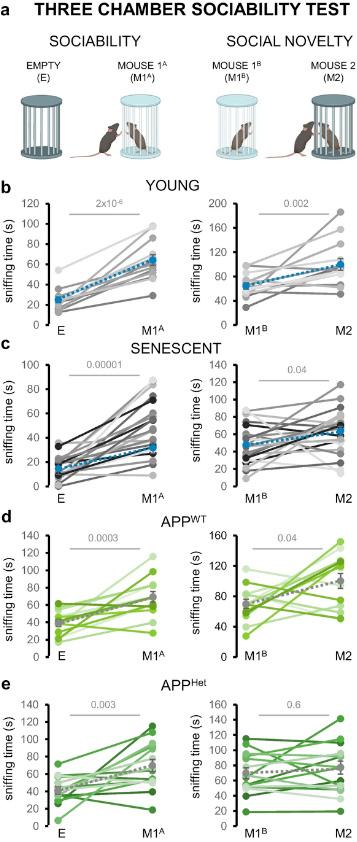
Impact of natural and pathological aging on cell proliferation in the marginal ventricular-subventricular zone (VSE). Confocal images of PCNA staining in the VSE proliferative niche are presented, with additional images showing OMP and PCNA double staining. No overlapping signal between the markers indicates different maturation stages of cells. Dispersion plots illustrate the number of PCNA+ cells and Sox2+ cells in the marginal VSE. Using two-way ANOVA with Tukey’s test, statistical analysis indicates significant differences. Data were collected from slices of at least three animals per condition.
Source: Portalés A. et al., Molecuar Neurobiology (2023)
Patients suffering from neurodegenerative diseases have frequent episodes of aggression, apathy and social isolation, which greatly reduces their quality of life and that of their caregivers. Therefore, it is of utmost importance to understand the changes that the brain undergoes in its structure and function as it ages, and what processes could be related to premature or pathological aging. This study provides new information on the different mechanisms involved in both types of aging, potential targets for the development of future therapeutic interventions.
Slowing down the damage to white matter in the brain can reduce relapses in patients with alcoholism
hronic alcohol consumption causes alterations in the brain microstructure that are noticeable in the white matter of the brain and progress even during sobriety. Slowing down the damage to the white matter in the brain can reduce the risk of a relapse in patients with alcoholism. Two laboratories of the Institute for Neurosciences, a joint centre of the National Spanish Research Council (CSIC) and the University Miguel Hernández (UMH) of Elche, have managed to protect the white matter of patients using a non-invasive method of transcranial magnetic stimulation. This work, published in the journal Psychiatry and Clinical Neurosciences, proves that the alteration of the white matter is a central characteristic of the pathology, and not a collateral damage of alcohol consumption, and opens a new therapeutic pathway to prevent relapses.
Researchers from the Plasticity of Neural Networks and Translational Imaging Biomarkers laboratories of the Institute for Neurosciences, led by Santiago Canals and Silvia de Santis respectively, already proved a few years ago that alcohol consumption causes damage to the white matter of the brain and that this damage does not stop when the person stops drinking, but get worse very noticeably in the first week of sobriety. In the new study, they have not only reproduced results from that previous research in a new group of patients, but have applied a non-invasive method based on deep transcranial magnetic stimulation (Deep TMS) that prevents the progression of damage to the white matter during sobriety.
According to researcher Mohamed Selim, the first author of the article, it is a non-invasive neuromodulating technique that consists of the application of a magnetic field repeatedly on the head. Thus, an electric field that activates large populations of neurons is generated. Although it is not a simple technique to perform from the clinical point of view because it requires specific facilities, it has already been used successfully to treat other addictions such as smoking.
A brain reconstructed from patient data and in which the region where TMS protects the white matter in a more significant way has been highlighted in blue. The meat-coloured hat marks the area of influence of the TMS. The blue region contains the nerve fibres (green and red) that connect several brain areas (yellow) whose activity is normally altered in patients and that the TMS intervention normalises.
In this study, which also involved researchers from Ben-Gurion University (Beer Sheva, Israel), the University Hospital of Linköping (Sweden) and the Central Institute for Mental Health (Mannheim, Germany), the experts have applied the magnetic stimulation treatment periodically for several weeks to a group of patients made up of people who were in the process of detoxification. In addition, to rule out a possible placebo effect, a simulation of this stimulation was performed on a group of control patients.
The researchers acquired images of the patients’ brains before they started the intervention and after receiving treatment. Indeed, they confirmed that only in those patients who had received the stimulation, the treatment had been sufficient to
stop the progression of the alteration in the microstructure of the white matter that occurs when patients stop drinking. And, even more significantly, their relapse rates had declined three months after treatment, so these are stable long-term results.
Alcohol use disorder is the most prevalent form of addiction, characterised by excessive and prolonged alcohol use. This addiction has a great burden on society, since, among the population aged 15 to 49, 3.8% of female deaths and 12.2% of male deaths are attributed to alcohol consumption worldwide. It is a chronic disease that alternates cycles of sobriety and relapse. Therefore, the main challenge, together with that of prevention, is to break those cycles to prevent the restart of consumption.
The white matter, the tissue that connects the different brain regions, is made up of the axons that interconnect the neurons and the glia cells that are with them, performing various functions. The researcher of the Institute for Neurosciences Silvia de Santis points out that one of these functions is the production of myelin that surrounds the axons and ensures their correct functioning. In addition, the expert explains that the alteration of the microstructure found in patients was directly related to the level of alcohol consumption. Importantly, they found similar results in two different animal models, which allowed them to study with invasive technologies, only available in animal experiments, the biological underpinnings of the change and to discover that they were associated with a decrease in myelin.
The evidence collected by the team pointed to the white matter as a possible therapeutic target. According to Selim, his reasoning was that brain stimulation, by virtue of a process known as myelin plasticity, could regenerate the white matter of patients and thereby protect the brain and prevent relapses. When the cells that produce myelin detect neuronal activity, they react by producing more myelin. In addition, progenitor cells mature, so there are more cells with the ability to myelinate axons.
After verifying that, when applying TMS treatment, the areas of the stimulated white matter were protected during sobriety, the researchers found that, in addition, they regained their function. Communication between protected brain regions was more like that of healthy subjects than that of subjects with alcohol use disorder. At the same time, patients reported a lower alcohol craving, and it was registered, after 3 months, that relapses had decreased.
Now the researchers are considering studying in detail the mechanism of plasticity in order to propose even more effective therapies. Their goal, according to Santiago Canals, is to refine the protocols of brain stimulation and combine them, possibly with pharmacological treatments aimed at exploiting to the maximum the therapeutic window they have discovered.
This work has been possible thanks to the funding of the Horizon 2020 Research and Innovation Programme of the European Union, the Ministry of Science and Innovation of Spain, the State Agency for Research, the Severo Ochoa Research Centre Programme, the Generalitat Valenciana, through the PROMETEO and CIDEGENT aids, the Swedish Research Council, “la Caixa” Fundation and the Marie Skłodowska-Curie-COFUND agreement.
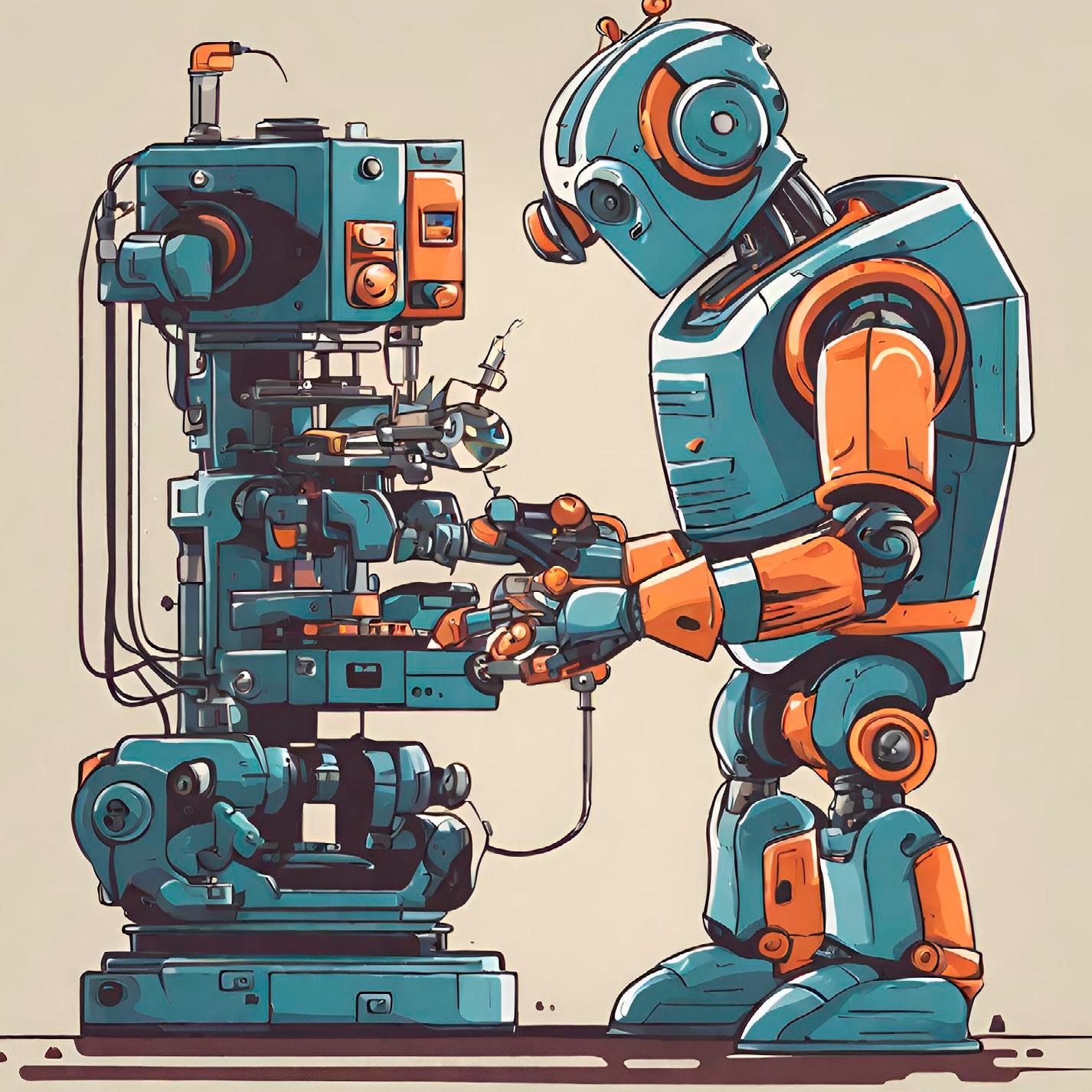
Safely accessing the surface of the brain. This is the objective of the new technique developed by researchers from the University Miguel Hernández of Elche (UMH) in collaboration with the IMED Hospital of Elche and the Institute for Health and Biomedical Research of Alicante (ISABIAL). This technique, pioneering in the medical world, uses Medtronic’s “Stealth Autoguide” robot and an advanced neuronavigation system that allows neurosurgical personnel to perform the implant in a minimally invasive manner. Although hopeful results have already been obtained, this is ongoing research that is not ready to be applied to the general public yet.
A team of researchers, led by the UMH, has successfully performed the first insertion of brain microelectrodes in a blind person using this new procedure at the IMED Elche Hospital and hopes to use this new technique in the next blind volunteers who collaborate in their research. The work has been published in the Journal of Neurosurgery
The new technique is part of a project led by the group for Biomedical Neuroengineering of the Institute for Bioengineering of the UMH. The project consists of developing a new brain implant that, through microelectrodes, can help blind people or people with low residual vision to improve their mobility and even, in a more ambitious way, to perceive the environment around them and orient themselves in it. “This technology means being able to safely access the surface of the brain”, explains Eduardo Fernández, project director and member of the Centre for Biomedical Research in Network in Bioengineering, Biomaterials and Nanomedicine. “To this end, we have been working for several years on improving surgical techniques for implanting brain microelectrode arrays in close collaboration with the Neurosurgery Service of the General University Hospital of Alicante and the IMED Elche Hospital.” In addition, he adds that the new technology they have developed has also had the collaboration of Medtronic, a leading company in the field of medical technologies, and from Germán Sempere and the company 3DNeurotrainer of Ibi, which created an exact replica of the head of the volunteer patient to plan the surgery in advance.
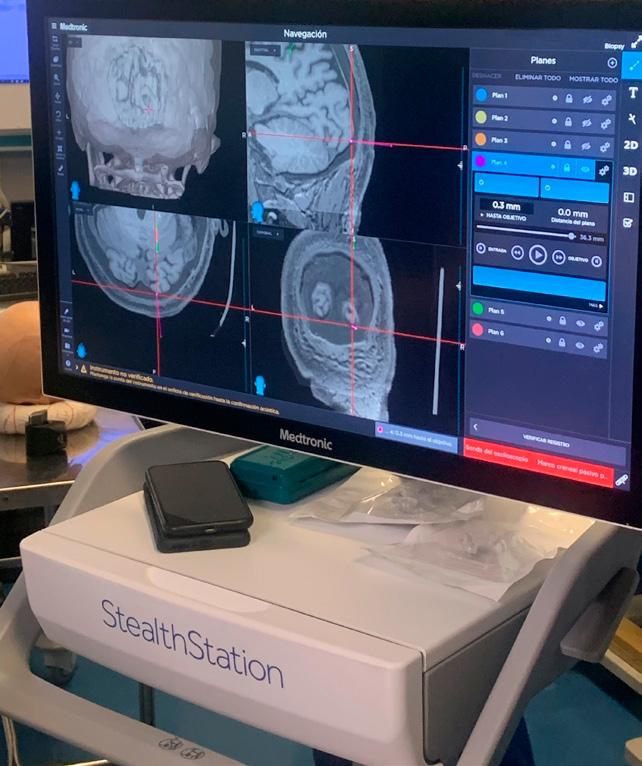
“This technology means being able to safely access the surface of the brain”, explains Eduardo FernándezNavigation station used in surgery. Researchers explain that the robot allows adjusting the position and orientation of microelectrodes in real-time and precisely, reducing damage to brain structures. They use a system similar to GPS based on images previously obtained through magnetic resonance imaging and computed tomography to achieve this.
This is the first time that an insertion of this type of microelectrode has been performed with the help of a surgical robot, as Professor Eduardo Fernández explains. “The results are encouraging, since this technique allows insertion in a more precise and less invasive way, which improves clinical results and reduces the risks of complications”, says the expert. Dr Pablo González, coordinator of the neurosurgery team that has performed the procedure, also emphasises that the robotic system allows them to guide the insertion of the electrodes and perform the surgery through a small millimetric hole, which avoids having to perform a craniotomy or to open the skull.
The researchers explain that the robot allows to adjust the position and orientation of the microelectrodes in real time and in a very precise way, which reduces damage to brain structures. To do this, they use a system similar to a GPS that is based on images previously obtained by MRI scan and computed tomography. The precision achieved with this technique, minimally invasive, means that people who participate in the study can be released early and have much less discomfort than in a normal postoperative period. In addition, it also has a positive impact on the quality of visual perceptions induced by implanted microelectrodes.
In the context of this research, UMH Professor Eduardo Fernández emphasises that the development of brain visual neuroprostheses is a clear need for the future, since, unfortunately for many blind people, there are no useful treatments or assistive devices. For example, patients with very advanced degenerative retinal diseases, people with severe glaucoma, or people with optic nerve disorders cannot benefit from the retinal prostheses that are currently being developed. In these cases it is necessary to send the information of the environment in front of the blind person directly to the part of the brain that processes vision. Preliminary results from the UMH group suggest that this approach could help provide a limited but useful vision of the environment, especially for tasks such as orientation and mobility. However, it also clarifies that it is a very complex field and that progress must be made little by little and not create false expectations.
The study has been funded by the Ministry of Science and Innovation, and by the European Commission within the H2020 programme, within the framework of the NeuraViper and ENTRAINVISION projects.

“The results are encouraging, since this technique allows insertion in a more precise and less invasive way, which improves clinical results and reduces the risks of complications”
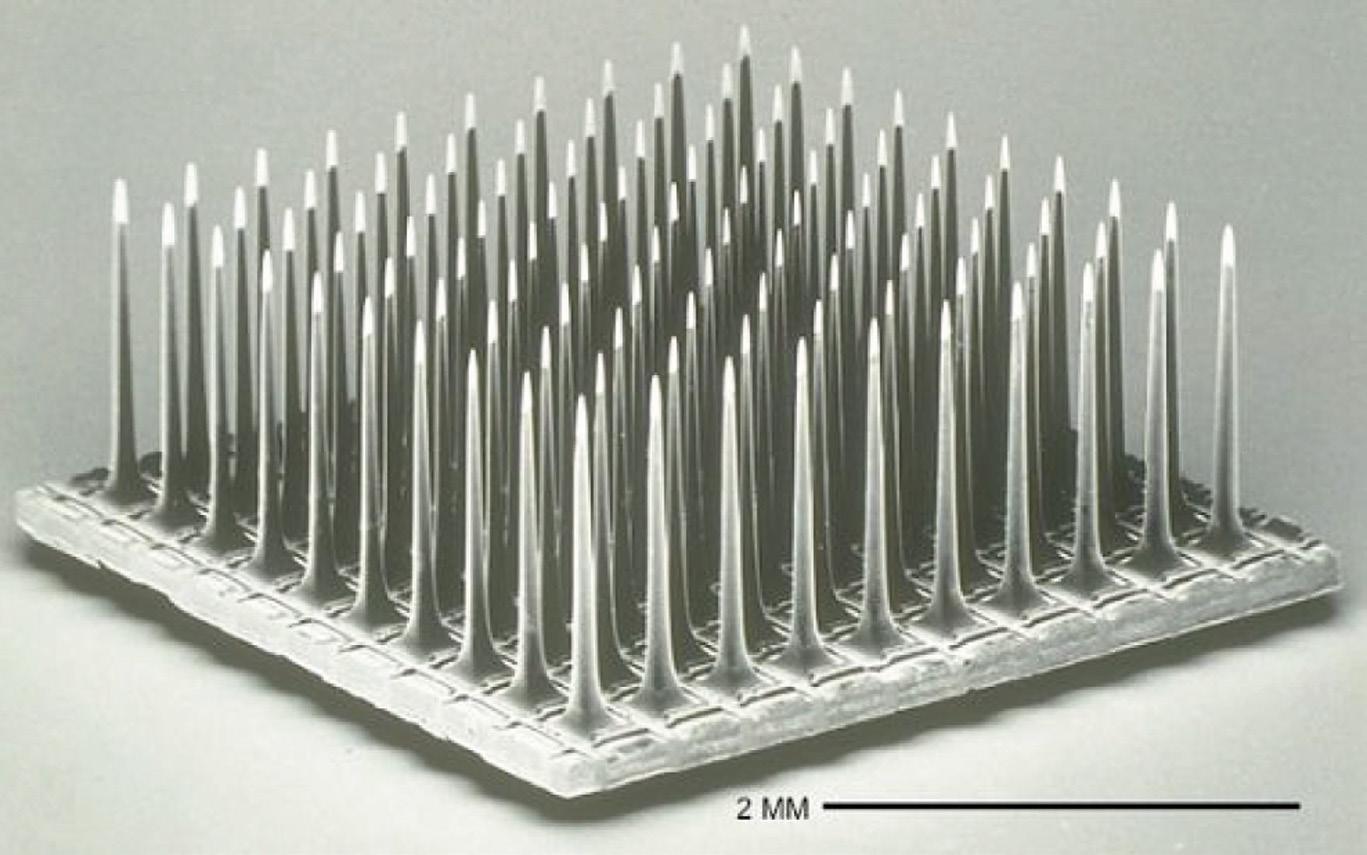
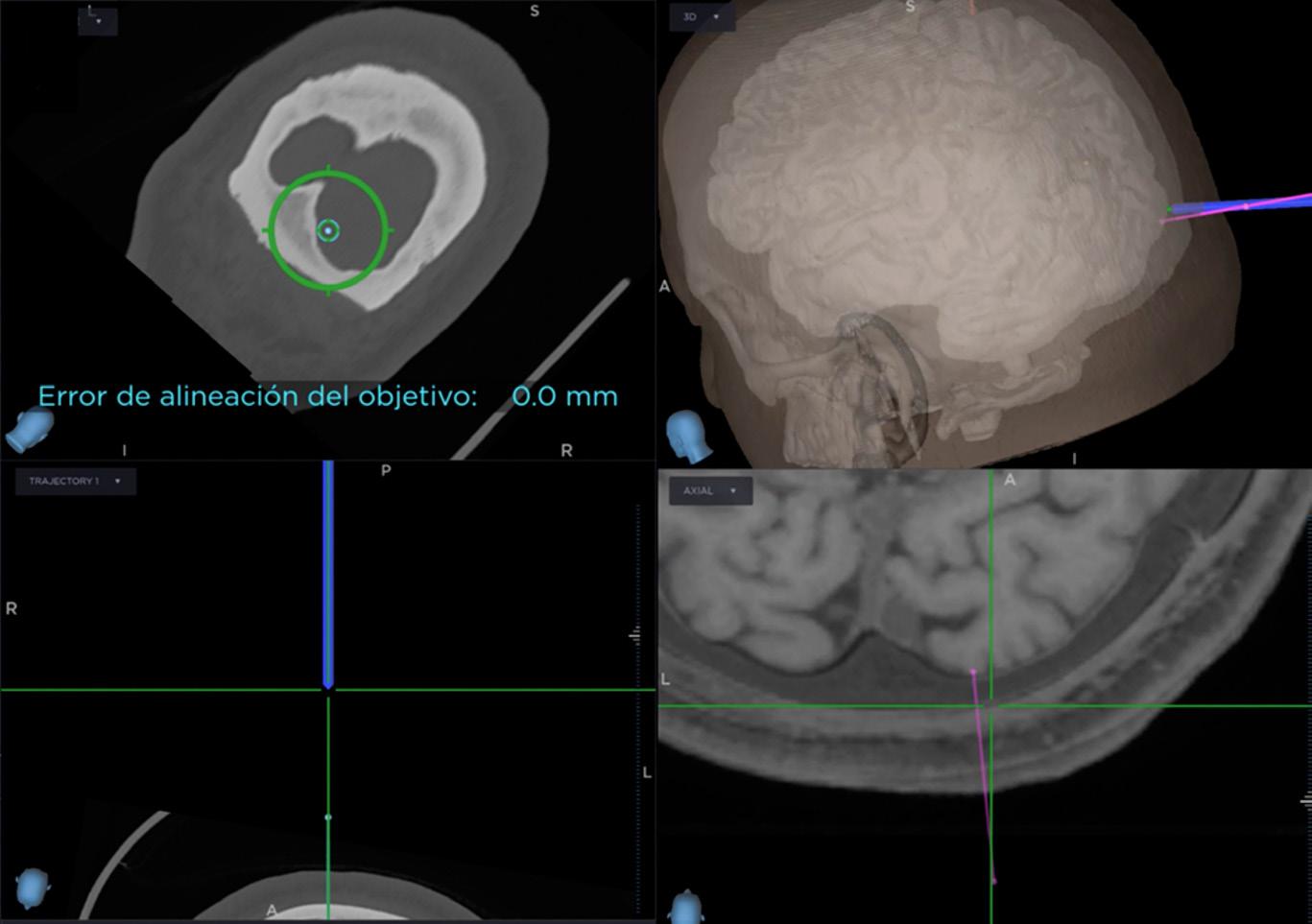
Red blood cells could be the key to treating viral infections in fish farming
The Laboratory for Red Blood Cells in Antiviral Immunology of the Institute for Research, Development and Innovation in Sanitary Biotechnology of Elche (IDiBE) of the University Miguel Hernández (UMH) of Elche, led by researcher María del Mar Ortega-Villaizán, conducts experiments on the red blood cells of fish, also called red blood cells, in the ALBA Synchrotron, where UMH Alumni Ana Joaquina Pérez Bera is a scientist of the MISTRAL light line. A synchrotron is an infrastructure that accelerates electrons at speeds close to that of light. By moving this fast, electrons emit a specific type of light, synchrotron light, which is used to study matter at very small scales. If you want to know more, we’ll explain how this facility helps to shed light on the future of fish consumption on the planet.
Most of the fish we consume does not come from open sea fishing. It is grown in fish farms, where the viral infections suffered by fish are a serious problem because fish infect each other quickly and die. In the case of humans, we know a lot about our immune system, about how different cells in the body react to infections, and what we can do to fight them. However, in the case of fish, we still do not know enough about their immune system. Giving them drugs is not good for the environment or for consumption. In addition, there are no fully effective treatments for viral infections, so science is trying to find vaccines or other treatments that prevent or stop viral infections in fish farms.
IDiBE-UMH researcher María del Mar Ortega-Villaizán has been studying for years how red blood cells in fish are responsible for sounding the alarm when a virus infects these animals because she wants to know what role they can play in creating an effective, organic and sustainable treatment for use in fish farms. Now, her laboratory is using synchrotron light, that is, electrons accelerated by magnetic fields at 99.9999985% of the speed of light, to see exactly what happens to fish red blood cells when they are attacked by a virus or treated with a vaccine.
There are several techniques to know what is going on inside a cell. One of them is the polymerase chain reaction (quantitative PCR). If you know the genetic code of the gene you are looking for, a cytokine, for example, you can know how much of this gene has been expressed in the cell. Another technique is immunofluorescence: fluorescent molecules are attached to an antibody to mark a specific protein to be located. If the antibody finds it, it will stick to it and the protein will shine, so it will be easy to see under the microscope. “This technique is more complicated in our experiments”, explains the researcher, “because antibodies designed for fish are scarce, most are designed for mammals.” However, these techniques and some more are those commonly used in the Laboratory for Red Blood Cells in Antiviral Immunology of the IDiBE-UMH to find out how the red blood cells of fish act to protect the body.
“With quantitative PCR and immunofluorescence techniques we have obtained a lot of information and have proven that red blood cells in fish have a very important role in the immune response to a viral infection, even if the red blood cells themselves are not infected”, explains the scientist



in charge of the study. They have also found that they are involved in the immune response that triggers the vaccine against the virus. To go further, in recent years, Ortega-Villaizán and her team have used a novel technique – synchrotron light – to see, in three dimensions and in native conditions, what happens inside the red blood cells of fish when they try different treatments on them.
“X-ray tomography can be performed with other equipment, but it is faster with a synchrotron. A synchrotron achieves in two days what would take months to analyse in other way”, explains Ortega-Villaizán. To analyse a cell in a conventional electron microscope, you have to process it first: fix it in paraffin, cut it, dye it with different reagents to see its parts… It is a slow process. With the photons generated by synchrotron light, it is not necessary. The X-ray beam at a given energy, called the water window, goes through the water of the cell as if it were transparent, but it collides with the carbon and nitrogen molecules that make up the different parts of the cell. That light is absorbed by the carbon, sulphur and nitrogen atoms that make up the cell and enables us to clearly see the organelles of a cell in 3D. In addition, the flashing light of a synchrotron can produce up to a thousand pulses per second, enabling us to study very fast processes, such as chemical reactions.
Research grant at the ALBA Synchrotron funds the studies by public institutions that want to use synchrotron light for projects with a scientific objective. Thus, the researchers of the
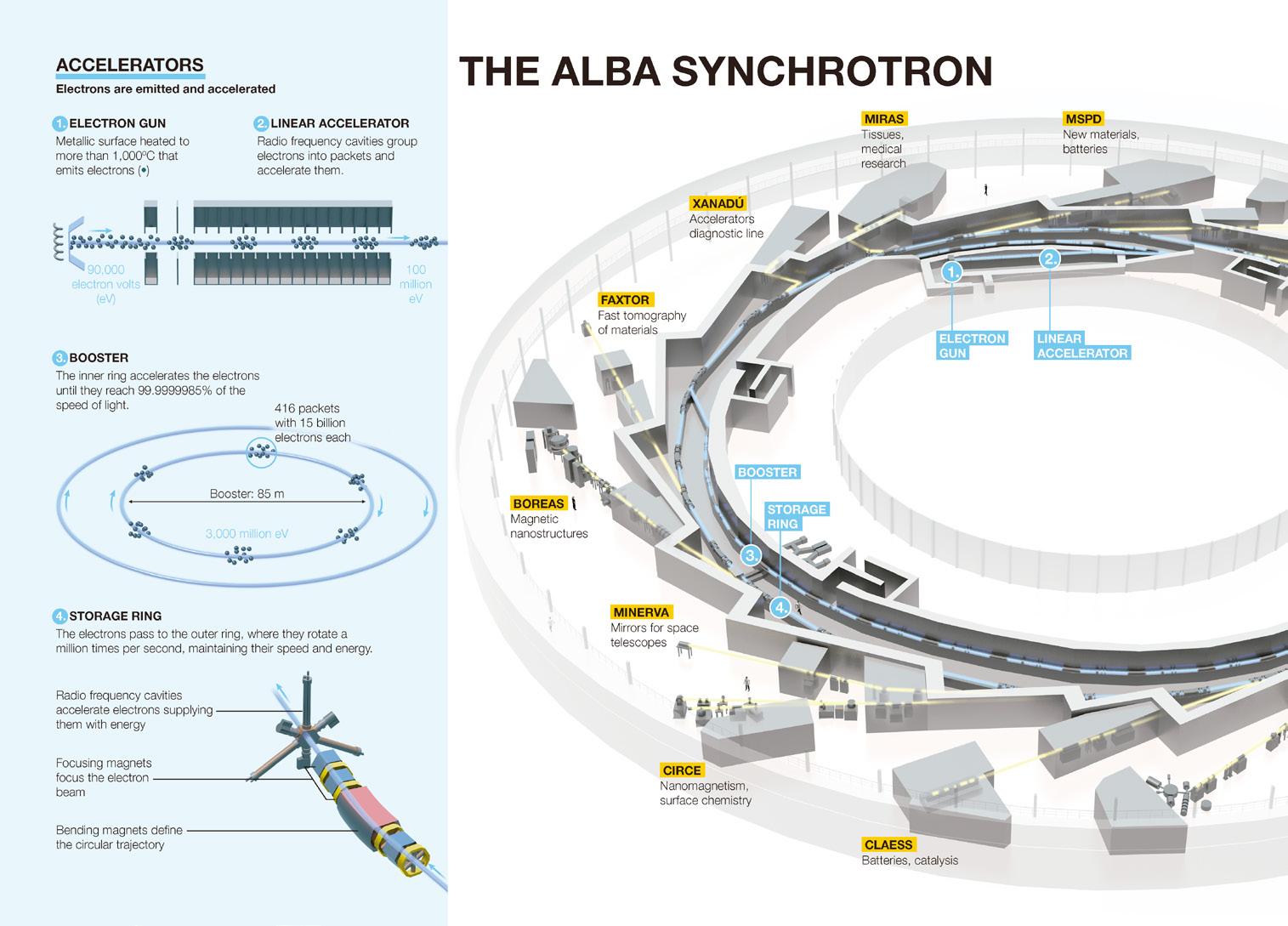
IDiBE have travelled several times to Cerdanyola del Vallès (Barcelona) to carry out their experiments in these facilities. Synchrotron is sometimes confused with Switzerland’s Large Hadron Collider (LHC). Actually, they are not the same. At the LHC, protons are accelerated to make them collide and study their properties, while at ALBA electrons are accelerated to generate light and use this light for other purposes. Since protons are much heavier than electrons, they must ‘run’ through a much larger circuit to accelerate. Therefore, the LHC has a circumference of 28 kilometres, while the perimeter of the facilities in Barcelona is less than 300 meters.
At ALBA, to generate light, metals are heated to more than a thousand degrees Celsius until their electrons have enough energy to detach themselves from the material. Then, electric fields are used to drive electrons at near-light speeds in a straight section, and then injected into a propelling ring. It would be like a velodrome.
But it is not called a velodrome or simply an electron accelerator because the key to the matter is that, for its light to be useful, it has to be stable and always have the same properties. This is achieved by synchronising the impulse and the rotation speed of the electrons. Hence its name: synchrotrons.
Throughout this synchronised race, the light emitted by the electrons is captured and modified depending on the expe-
riment you want to perform. If you could measure the space between the carbon atoms that make up a cell with a very small ruler, we would see that they are about 10-10 metres, that is, 0.0000000001 metres. This is precisely the wavelength of the X-rays that electrons can emit in the synchrotron and, for this reason, they are useful for seeing the interaction between the light beams and the molecules that are inside the red blood cells of the fish. ALBA has thirteen beamlines. There, the teams modify the beam to create different types of X-rays according to the experiment to be performed and then focus it toward the sample.
Ana Joaquina Pérez Berna, a graduate in Biochemistry and a PhD in Molecular Biology at the UMH, is one of the scientists in charge of these beamlines of the ALBA Synchrotron. “The projects that come to MISTRAL have gone through an international committee, and for me it was a great joy to see that the project of the UMH had been chosen. Having scientists of the UMH as users is a real pleasure”, says the researcher. In particular, Ana Joaquina Pérez manages the experiments of the line MISTRAL in which biological samples can be analysed. “There are only four lines of light like MISTRAL in the world where we can perform X-ray cryotomography”, explains the expert. This technique enables accessing the cells and visualising their interior in 3D. They can see the changes that a virus causes in the cell during infection, study viral factories, and understand which organelles are
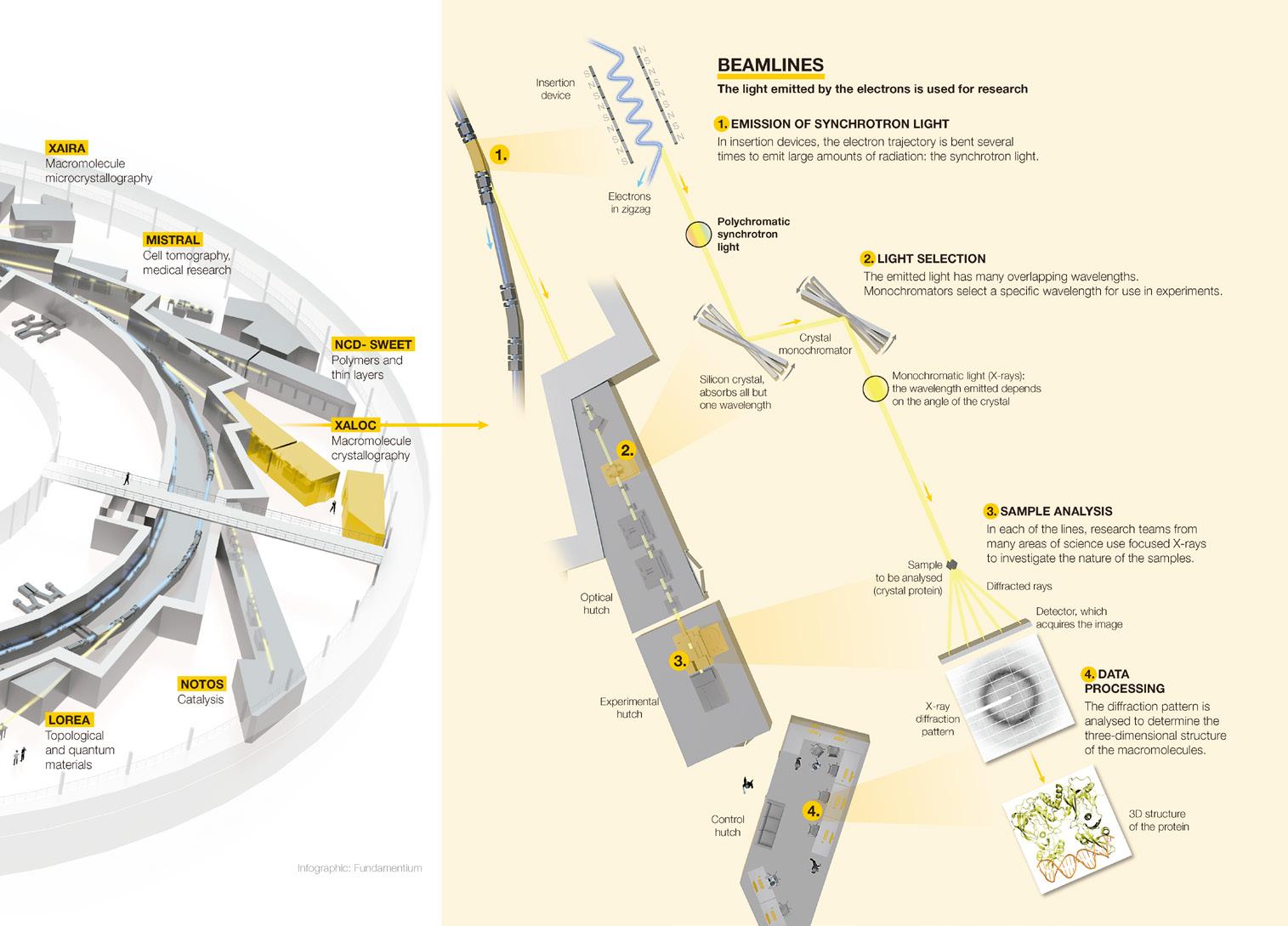
modified. They can also tell whether or not the cells have healed after administering antiviral drugs.
In addition, they study other fields applicable to health. In oncology, they have worked with different anti-cancer agents to know which of them is more effective or simply to locate the drug inside the cell and thus understand its mechanism of action and improve its effectiveness. “Lately we have been working with biopsies of patients suffering from rare diseases to better understand the disease at the subcellular level and try to cure them with gene therapy”, explains the scientist. The experiments with their microscope enable selecting which type of gene therapy is most effective because cells can be scanned like with a CT scan and see inside them.
In the case of fish viral infections, what can happen when a pathogen enters a cell is that the cell fragments it and then “shows” it to other cells of the immune system to activate defences and alert the immune system. The fact that there are more endoplasmic reticulum and more mitochondria in vaccine-treated red blood cells means that the cell is using more energy and producing more protein. Red blood cells have gone beyond breaking down the virus: they are sounding the alarm. “We still don’t have the image of red blood cells as cells of the immune system”, explains María del Mar Ortega-Villaizán. We only think of them as transporters of
oxygen and carbon dioxide in the blood. With the work of the group for Erythrocytes in Antiviral Immunology of the UMH, one day textbooks will be rewritten.
With synchrotron light, red blood cells of fish that have been treated with a DNA vaccine (Image 2, Image 3) can be compared with other red blood cells treated with a neutral substance, control. Image 1.
The first thing of these cells that may stand out is that they have a nucleus. Indeed, while mammalian red blood cells lose their nucleus when they mature, other animals such as amphibians, reptiles and birds maintain it. In the case of fish, only the abyssal luminescent fish (the family Gonostomatidae) have anucleate red blood cells in their blood. In addition, it can be clearly seen that the cells that have come into contact with the vaccine are more active because they have more organelles than the control cell. To achieve these results, about 500 images are processed and a three-dimensional reconstruction is done by painting, layer by layer, each of the structures that are inside the cell. These images were processed by UMH graduate Alba Manso, during the preparation of her Final Degree Project, and by UMH doctoral student María Elizabeth Salvador.
The Museo Nacional del Prado and the UMH collaborate on the project ‘Where do we look when we look at Hieronymus Bosch?’
How do we look at art? The panel depicting hell attracts more and more intensely the gaze of those who contemplate ‘The Garden of Delights’, one of the most iconic works of El Bosco and which is exhibited in Room 56A in the Museo Nacional del Prado. This is the main conclusion of the scientific study carried out jointly by the Institute for Bioengineering of the University Miguel Hernández of Elche (UMH) and the Museo Nacional del Prado.
The research involved 52 people, from Spain, Italy, France, Argentina, Colombia, Mexico, Chile, Australia and the United States. The study has been carried out by the Group for Biomedical Neuroengineering of the UMH, directed by Professor Eduardo Fernández Jover, and it has applied advanced technologies to delve into how people behave in front of the painting.
How we look at art
The study of the UMH has allowed to generate a ‘heatmap’ showing the parts of the picture that most attract the attention of each of the observers.
The technology used in the study allowed to record the position of the subjects in the room, measure the time each person looked at the panel and what part of the work they paid attention to. This technique also allowed registering, simultaneously with observation, the size of pupils, which provides relevant information on emotional responses. Thus, collected the data and put in a comparable magnitude (seconds per square meter), since the three panels do not have the same size, the results indicate that the average time of observation of the panel of Hell was 33.2 seconds per square meter, compared to the 26 sec/m2 of the central panel and the 16 sec/m2 of Paradise. This difference is also clearly seen in the time of observation per panel. The visitor spends 30.9 sec/m2 with the Hell panel, compared to the 21.6 sec/m2 of the central panel and the 12.6 sec/m2 of the left panel, corresponding to Paradise.
One of the latest theories developed from Art History about this triptych, painted around 1,500, conceives it as a piece for conversation. Apparently, already in the Nassau Palace in Brussels (Belgium), the first destination of the triptych, its owners showed it to the elite of the time and talked about it, something that happens daily in the room where it is usually exhibited in the Prado, the room registering the highest data in terms of the number and time of visits. The study has measured, for the first time, what the average duration of public observation is, which is 04:08 minutes.
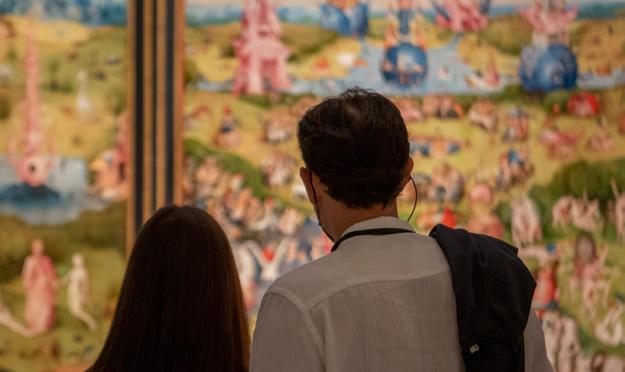

The study has allowed to generate a ‘heatmap’ showing the parts of the picture that most attract the attention of each of the observers
Another of the most illustrative results of the study has been to obtain the type route that each of the 52 people analysed has carried out with their eyes when observing the triptych. For this purpose, eye-tracking glasses have been used, which, connected to a computer, independently recorded head direction, eye direction and saccadic movements (those fast and simultaneous movements performed by both eyes when they are observing), as well as the size of each of the pupils. It has also been very revealing to see that this visual tour starts – in 46% of the cases – from the left panel of the work, then continuing to the central one and ending with the right panel.
As a complement to all this, the study has also established an iconographic measurement, according to the time of observation of more concrete elements within the work such as the fountains, some birds or the mysterious self-portrait of the painter; the only one that differs in scale from the rest of the characters. This has allowed to generate a ‘heatmap’ showing the parts of the picture that most attract the attention of each of the observers.
The UMH study has made it possible to generate a ‘heat map’ that reflects the parts of the painting that most attract the attention of observers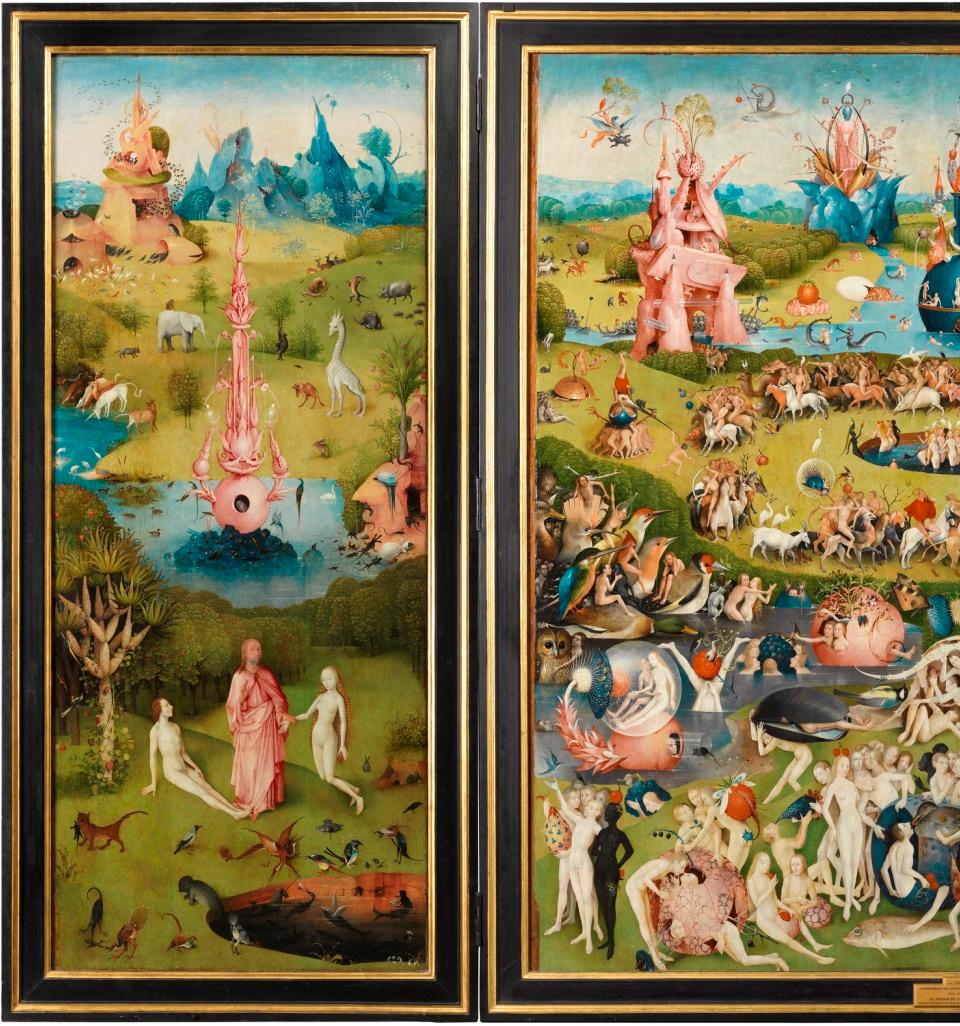

The EdgeAISat project, led by the company EMXYS of the PCUMH, kicks off to take Artificial Intelligence to space
The spin-off EMXYS of the Science Park of the University Miguel Hernández of Elche (PCUMH) – an aerospace engineering company that designs and manufactures satellites for high-performance applications – has launched the EdgeAISat project. With this initiative, an evolution of its ODALISS satellite platform will be developed to implement Artificial Intelligence in space. This project, led by EMXYS, also involves the University Miguel Hernández and the Polytechnic University of Valencia (UPV). EdgeAISat is funded with the support of the Valencian Agency for Innovation (AVI).
The EdgeAISat project, which has been selected within the framework of the AVI Strategic Cooperation Projects Programme, considers the development and manufacture of a flight model of a satellite for Earth observation. It is designed to implement applications of what is called “Artificial Intelligence at the Edge” or Edge AI. This satellite will be integrated and ready for launch by the end of 2025.
EMXYS Director of Technology (CTO), UMH Professor Francisco García de Quirós, points out that the objective of EdgeAISat is to take a significant part of the processing of images to the place where the data is obtained, in this case on board the satellite itself. “This is a double advantage: on the one hand, it significantly reduces the information the satellite has to send to Earth because its AI algorithms extract the most relevant information from the large number of images the satellite can obtain. On the other hand, it simplifies the processing of data on the ground, which reduces the waiting time to obtain valid information”, says García de Quirós.
In this way, the system will be able to almost instantly detect important events before a human analyst is able to do so. For example, forest fires, volcanic eruptions, illegal spills, etc. In this sense, EMXYS CEO, UMH Professor José Antonio Carrasco, underlines that EdgeAISat is a great boost to the development of the company’s technology for high-performance satellites. “This project allows us to evolve the electronic computer systems we are currently commercialising to a new level. This will allow us to be more ambitious in the technical complexity of the space missions we can carry out”, Carrasco says.
EMXYS participated in its first space mission in September 2007. It did so aboard the Russian spacecraft FOTON-M3, which was launched from Baikonur on a Soyuz rocket. In this mission, critical electronic systems designed and manufactured by EMXYS for mission YES2 were put into orbit. This resulted in a Guinness record in 2009 for the largest space structure put into orbit. Since then, the PCUMH company has participated in three more space missions, including a combined mission of NASA and the Japanese Space Agency (JAXA). It was launched in 2010 from the Uchinoura Space Centre aboard an SS-520 suborbital rocket that flew to 300 km altitude.
Since the company started, EMXYS has worked closely with research groups from both national and international institutions. Among them, the Colorado State University, the group of the Nobel Prize in Physics Anton Zeilinger of the

University of Vienna or the Royal Observatory of Belgium. In this sense, the participation of the Polytechnic University of Valencia and the University Miguel Hernández in EdgeAISat represents a working group that has been collaborating on projects of the European Space Agency (ESA) for over 10 years.
The researcher responsible for the Microwave Applications Group of the UPV and president of the Executive Committee of the Val Space Consortium (VSC), Professor Vicente Boria, highlights that the technological advance, in terms of the payload embarked on the satellite that is intended to be developed, as well as the example it implies in terms of the integration of solutions provided by various entities of the Valencian Community is already a reality.
For his part, the head of the Industrial Electronics Group of the UMH, Professor Ausias Garrigós, adds that the participation in this project allows the group to transfer part of the research carried out in recent years in the field of power systems for small satellites, and to establish new contacts with different groups in the Valencian Community to strengthen synergies with other space technologies.
The PCUMH spin-off is currently working on three shortterm space missions. In this regard, two of them will be launched in 2024: The OTD-1 demonstration mission of its ODALISS satellite aboard a Spectrum launcher of the German company Isar Aerospace and the GRASS instrument of the planetary defence mission of ESA, called HERA, to the asteroid Dydimos. This will be performed aboard a Falcon 9 from SpaceX. A scientific mission currently in integration will also be launched at the end of 2025.
In the medium term, EMXYS is working on several proposals for both scientific and commercial missions. Satellites based on its ODALISS platform will be intensively manufactured in new facilities that the company is projecting in the province of Alicante and from where they will be commercialised globally.
AI generated image | UMHSapiensresearchers are developing an innervated skin organoid to understand the molecular mechanisms that cause pathologies
Ateam of researchers from the Institute for Research, Development and Innovation in Sanitary Biotechnology of Elche (IDiBE) of the University Miguel Hernández (UMH) are developing a model of innervated human skin with 3D printing to understand mechanisms that cause various pathologies affecting the sensory nervous system and whose symptoms are manifested in the skin. IDiBE researcher Asia Fernández points out that, until now, skin obtained by bioprinting has been used for the treatment of large burns, but has not been included so far in the sensory system. The aim of this project is to connect the two systems – skin and nervous system – to help understand the molecular mechanisms responsible for sensory pathologies.
Professor of Molecular and Cellular Biology at UMH Asia Fernández explains that in this project they are trying to “connect the nervous-sensory system, that is, connect and innervate this skin in order to give sensory capacity to it. This is a model that could be very useful both to understand the molecular mechanisms of dermatological pathologies, and also to study the toxicity of certain compounds, drugs, even cosmetics, to see if they do not cause irritation or alter the skin.”
From the point of view of skin pathologies such as psoriasis or pruritus, this research will help to discover new drugs that may be useful. The IDiBE team of the UMH has proven that these phenomena occur with the intervention of the sensitisation of the skin of the peripheral nervous system. Currently, the removal of skin cells through human samples is being carried out. These samples are collected from surgeries that allow to get a sufficient amount of material to obtain printed skin. The challenge is to innervate this skin with human sensory neurons obtained through the transdifferentiation of fibroblasts, a cell type present in the skin.
Obtaining skin by 3D printing allows to reduce the use of animals and, in addition, to create a system similar to the human system. According to Asia Fernández, “the results obtained with this study system would be more easily transferable to the clinic, and it would reduce the high rate of failure we find when we try to extrapolate the results obtained in animal models to humans.”

This model could be very useful both to understand the molecular mechanisms of dermatological pathologies, and also to study the toxicity of certain compoundsA lab technician works with the new 3D bioprinter. Author: Ivan Vaz
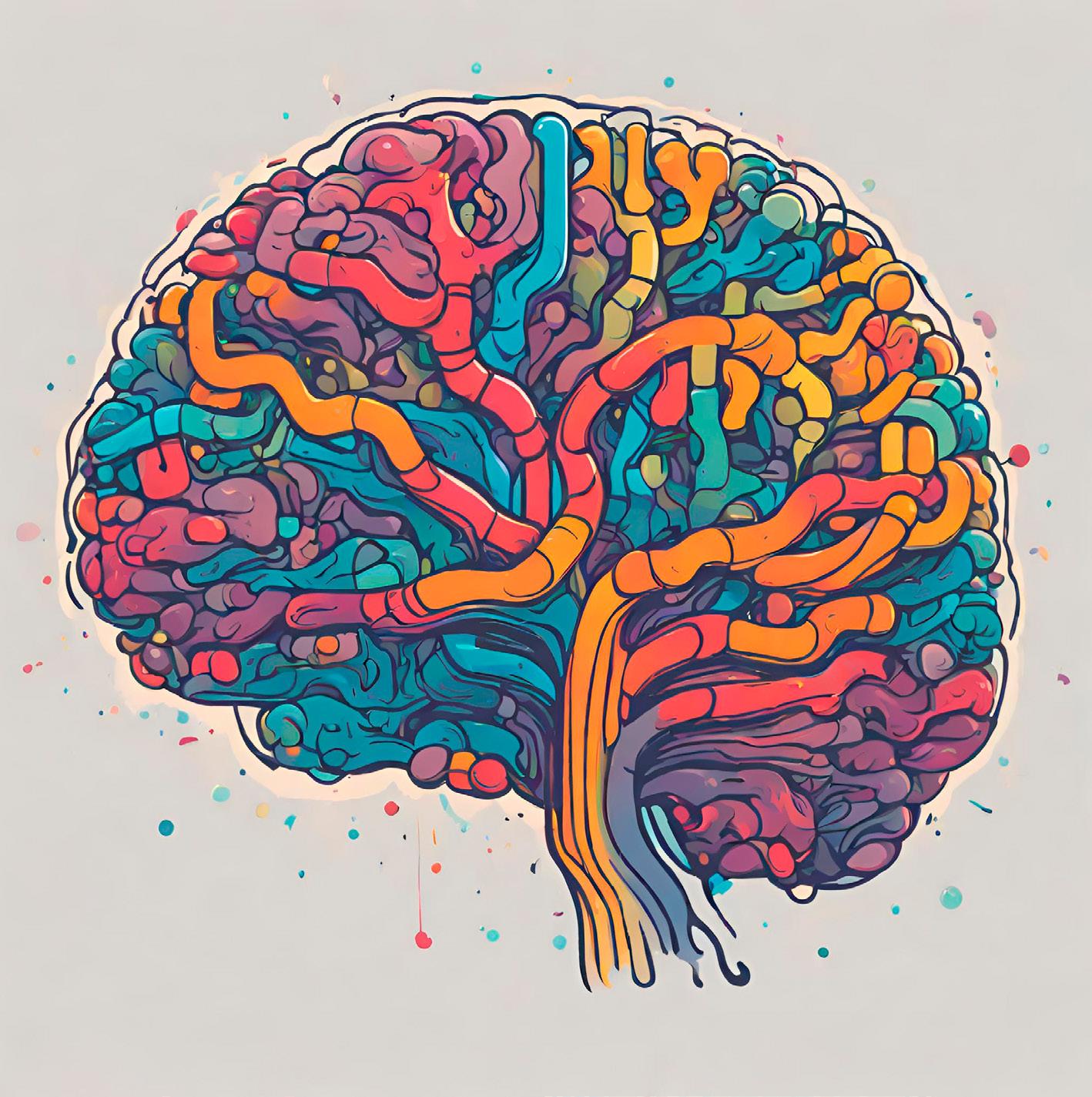
How sensory information is transmitted between brain hemispheres innovation
esearchers from the Institute for Neurosciences (IN), a joint center of the University Miguel Hernández (UMH) of Elche and the Spanish National Research (CSIC), have carried out a study that has confirmed, in a pioneering way, through physiological studies, that there is a double representation between hemispheres, which enables the perception of continuity, without interruptions between both sides of the body. The work has been published in the journal Science Advances.
The study carried out by researchers from the Sensory-Motor Processing in Subcortical Areas laboratory, led by Ramon Reig at the Institute for Neurosciences (IN), addresses a hypothesis known as Midline Fusion Theory (fusion theory or unification of the midline).
The brain has a very concrete way of processing information from the sense of touch. Stimuli felt on the left side of the body are processed in the right brain hemisphere and vice versa. This is widely known, but until now it had not been described in detail how the two hemispheres share this information.
The Midline Fusion Theory was postulated in 1989 and, based on anatomical observations, established that the areas of the brain that encode sensory information near the midline of the body sent large numbers of connections that crossed into the other hemisphere. So far, the presence of these axons had been observed, but IN researchers have proven the functional properties of those axons that cross and synapse with the other hemisphere in mice. These especially connect tactile information from the parts of the midline and generate an identical representation or activation of the information on both sides, enabling continuous sensory information processing.
To carry out this study, the researchers have used the system of the whiskers of the mouse, since these rigid hairs are tactile receptors that enable stimulating with great precision both the lateral zones and the zones of the midline, in addition, it is possible to observe in detail which part of the hemisphere responds to the stimulus. Experts were able to see that when a certain whisker of the nose of the mouse is stimulated near the midline (at the center of the same), a response occurs at a given contralateral location, and one-third of neurons in the homologous region of the opposite hemisphere also respond exactly the same. This explains how the brain can generate that tactile spatial continuity between both sides of the body.
Furthermore, thanks to the technique of registering neurons used (in vivo patch-clamp), the researchers also found that, when the tactile response occurs, in the opposite hemisphere (ipsilateral to tactile stimulation), through neurons that cross the corpus callosum, it receives the response that causes the activation of neurons, and also, a few milliseconds later, receives the inhibition needed to control the response. The correct excitation-inhibition balance of neurons is essential for the brain to develop its activity normally since a continuous state of excitation would trigger an epileptic brain.
Researchers have managed to describe in a precise way the complete circuit that communicates both brain hemispheres
In this work, whose first author is Roberto Montanari, the researchers have managed to describe in a precise way the complete circuit that communicates both brain hemispheres: the information perceived before a sensory stimulus travels through the callous body and is specifically processed in a very specific region of the primary somatosensory cortex, in the mouse the barrels of row A (RowA). Therefore, these represent a sensory center for interhemispheric communication.
In addition, they have verified that the information travels through a specific “lane”. The brain cortex that encodes the mouse’s tactile information is divided into rows and columns, each of which contains groups of neurons called barrels. The researchers have found that communication between hemispheres occurs in row A, “It is what is called heterotopic projection. For example, the barrels of row E barely project to row E of the other hemisphere, but do so mostly through row A”, Ramon Reig explains, and adds that this is very interesting because it is precisely in row A where the receptors of the whiskers of the middle line are located. Experts used a common anesthetic agent (lidocaine) to block all information coming from one side of the nose of the mouse to check what happened when the animal could only process the information on one side. Once again, they found that the information travels through row A connecting both hemispheres.
To validate these results, the researchers imitated what they had done at the sensory level in mouse whiskers using optogenetics techniques. The experiment consisted of directly stimulating the brain cortex with light to observe the response of neurons in rows A and, indeed, they observed that the response coincided and gave rise to the same phenomenon.
The researchers have found that the dorsolateral striatum both receives tactile information and also processes bilateral tactile information from both hemispheres. Reig’s laboratory at the IN studies striatum to learn how neurons in this brain region integrate sensory and motor information to produce a coordinated and accurate response. Problems in the function of this nucleus are related to motor disorders such as Parkinson’s disease. This new research also accurately describes the path that bilateral tactile information follows before reaching the striatum core region.
This work has been possible thanks to the funding of the Ministry of Innovation, Science and Universities, the CSIC Severo Ochoa Excellence Programme of the Institute for Neurosciences, La Caixa, and the ACIF Programme of the Generalitat Valenciana.
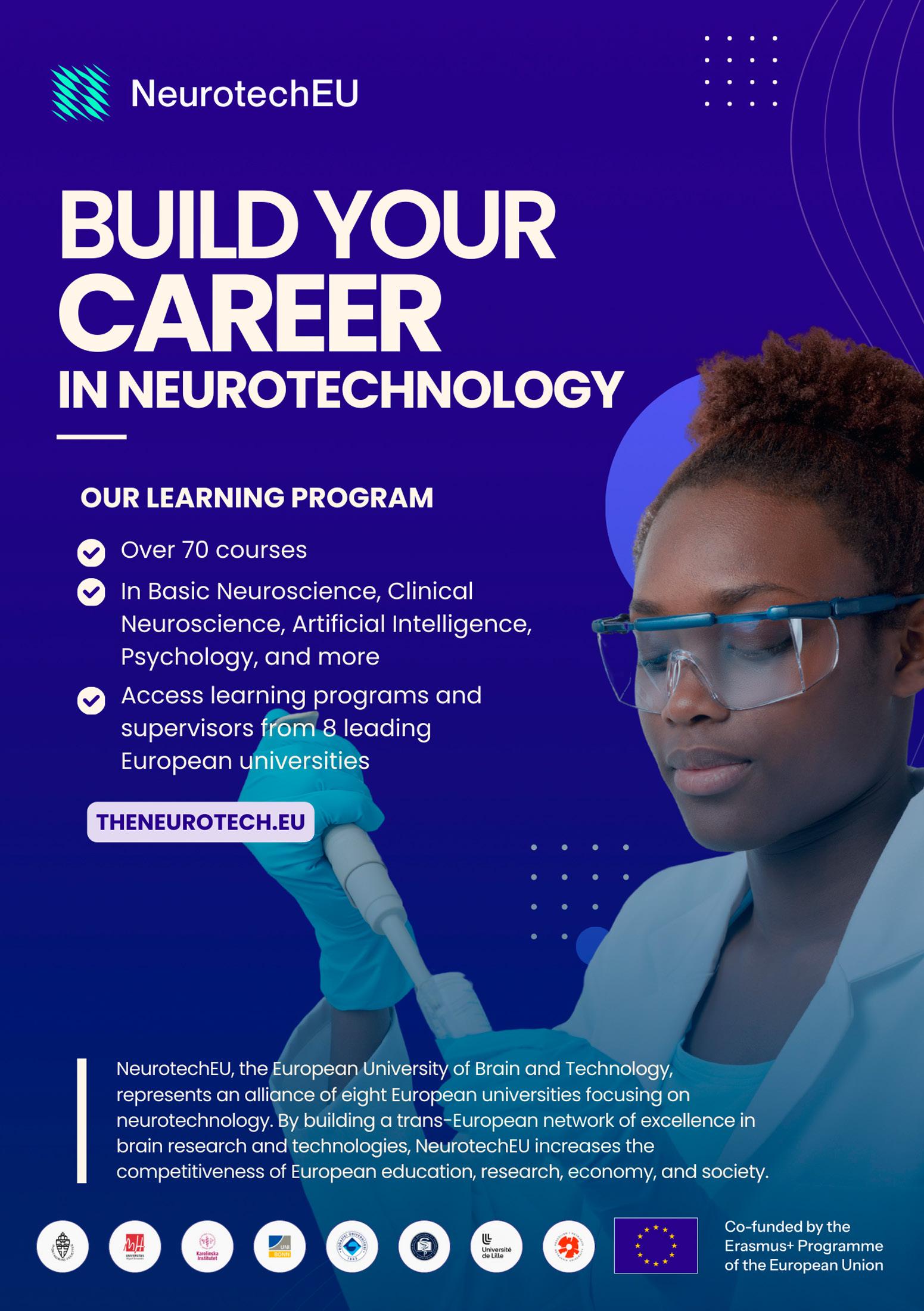
How are the senses formed? The jury of the Rei Jaume I Awards has announced the 2023 winners, among which is the researcher of the Institute for Neurosciences, mixed centre of the University Miguel Hernández (UMH) of Elche and the Superior Council of Scientific Research (CSIC), Guillermina López Bendito. Specifically, López Bendito has been awarded in Medical Research. Throughout her career, the neuroscientist has studied the structures of the brain where sensory information is interpreted, even before birth.
The jury has awarded her the Basic Research Award for her study of the processes underlying the formation of neural connections, where she proves that they are fundamental to normal brain function. Her work has shed light on the complex interactions between the sensory signals received by neurons and the molecules that are released, and the role of spontaneous brain activity in forming cortical maps.
Guillermina López Bendito is a PhD in Neurosciences from the UMH and a researcher specialising in the field of Neurosciences. She studies the formation and plasticity of brain circuits during embryonic and postnatal development. Her work has had a profound impact on the way we understand how defects in neural network assembly lead to adaptive plasticity and/or neurological disorders. Her research has as long-term aspiration to repair defective neural connections in patients with sensory defects such as blindness.
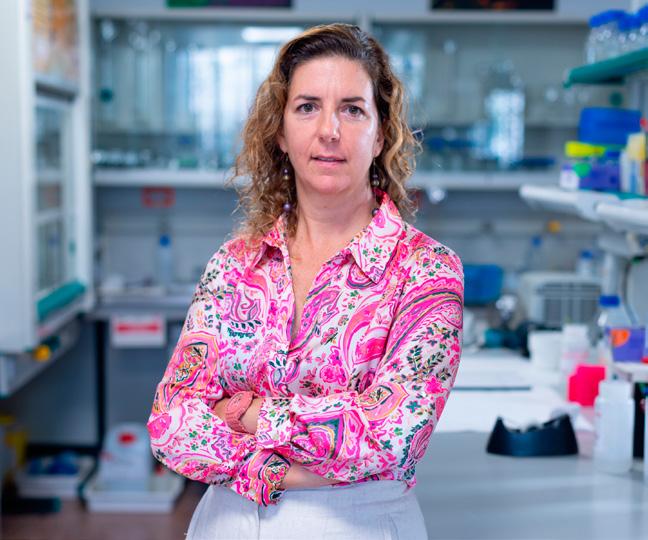
She is at the forefront of her field, as evidenced by the international repercussions of her results and the unique implementation of new technologies, which has resulted in publications and also in invitations to join societies, evaluation committees, editorial boards, as well as in the organisation of congresses and the delivery of talks in international forums and universities. Since 2008, she directs the Laboratory for “Development, Plasticity and Reprogramming of Sensory Circuits” at the Institute for Neurosciences, recognised as a Severo Ochoa Centre of Excellence.
A new instrument developed by UMH and the company Tearful applies 99% CO gas jets to stimulate corneal sensory nerves, evoking maximal reflex tearing
The use of the maximum capacity to generate tears as a parameter to diagnose dry eye disease is the objective of a study carried out by the group of ocular neurobiology of the Institute of Neurosciences, a joint centre of the University Miguel Hernández of Elche (UMH) and the National Spanish Research Council(CSIC). The paper, published in the journal The Ocular Surface, proposes eye stimulation with a gas, specifically carbon dioxide (CO2), to determine the maximum tear capacity of patients. A new device, called i-Onion, has been used for this research.
The dry eye is a disease that appears almost spontaneously with age and has many possible causes. Some experts point out that dry eyes occur when the epithelium of the cornea is damaged and tear production decreases, which ends up causing an alteration in the ocular nerves. However, the group of Ocular Neurobiology of the Institute for Neurosciences UMH-CSIC has found evidence in the laboratory that indicates that the process also occurs inversely; that is, the nerves of the eye are altered, and their abnormal functioning ends up causing changes in the corneal tissue and decreasing the rate of lacrimation.
People affected by this disease suffer enormous complications in carrying out daily activities. “It may seem like a banal alteration, but the fact that a person does not produce enough tears significantly decreases their quality of life because the slightest gesture of closing the eyelid is tremendously painful”, explains UMH Professor Juana Gallar.
The UMH researcher points out that one of the major complications of this disease is the lack of quantitative tools for its diagnosis since, so far, this process is usually carried out through interviews with patients. To fill this gap, researchers have determined that the patients’ maximum tear rate by stimulating their eyes with CO2 may be an effective indicator for assessing the risk of developing the disease. “During the research, we detected that there were people capable of generating a huge response to the stimulation, but there were others that showed a smaller response, and these are likely the ones who, although now they do not show it, in the future will end up developing dry eye”, points out the expert in ocular neurobiology.
The study was conducted using a new device designed by this research group in collaboration with the spin-off company Tearful. This device is i-Onion, a fully portable tool that allows the controlled stimulation of the eye with CO2 without the need to connect it to an external gas source or power supply. In addition, it does not require any specific infrastructure, which allows its use on an outpatient basis in any clinic.
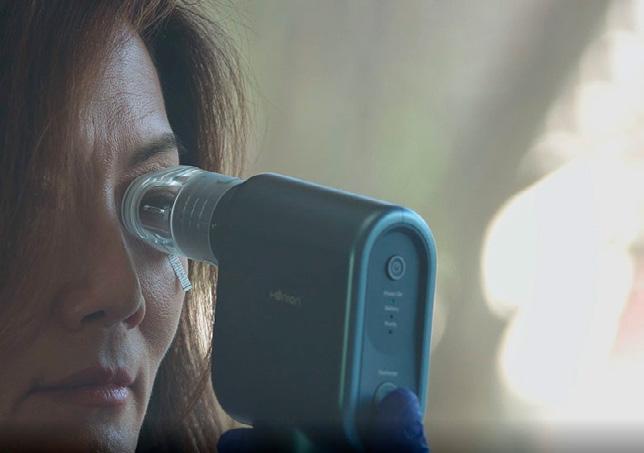
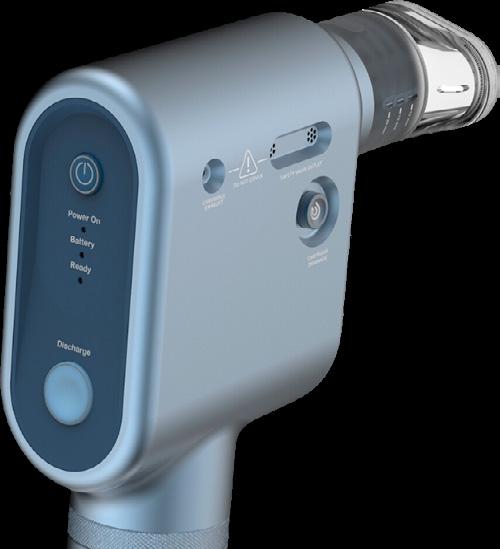
One of the major complications of this disease is the lack of quantitative tools for its diagnosis

Livestock farming affects the conservation of a threatened scavenger bird from the Canary Islands
Anew study led by researchers from the University Miguel Hernández of Elche (UMH) and the Doñana Biological Station (EBD-CSIC) concludes that the reproductive success of the Canarian guirre, an endemic subspecies of Egyptian vulture from the Canary Islands, depends to a large extent on the productivity of the ecosystem. This study, published in the scientific journal Science of the Total Environment, has been possible thanks to the 22 years of intensive monitoring – funded by the Cabildo de Fuerteventura, two LIFE-EU projects and the Ministry of Science and Innovation – of this scavenger bird.
The work of researchers at the UMH and EBD-CSIC has shed light on the complex interactions between environmental conditions, available resources and community policies that affect the reproductive success of the Canarian guirre, an endemic subspecies of Egyptian vulture (Neophron percnopterus majorensis). This species was widely distributed throughout the Canary archipelago, but at the end of the 20th century, it suffered a sharp decline and was classified as endangered. Currently, they persist only on the islands of Fuerteventura and Lanzarote, where their populations seem to recover thanks to the conservation plans.
The state of conservation of the Canarian guirre
The island of Fuerteventura is known for the number of goats it has. There, it is the main livestock species. However, due to changes in the subsidies under the Common Agricultural Policy, the number of livestock fell in 2013 from 100 heads per km2 to 50. This, in turn, caused changes in the vegetation of the island, subjected to less herbivory pressure by the goats. Since part of the diet of the guirre are vertebrates that take refuge and feed on that vegetation, when the grass is recovered, the bird has more food and reproduces more. Therefore, the study concludes that the number of livestock present on the island influences the survival of the species.
The research, which followed the populations of guirre of the Canary Islands from 2000 to 2021, shows that this population of scavengers is connected to the dynamics of the ecosystem. The researchers underline the importance of understanding how these interactions between the different elements that make up the food chains work,
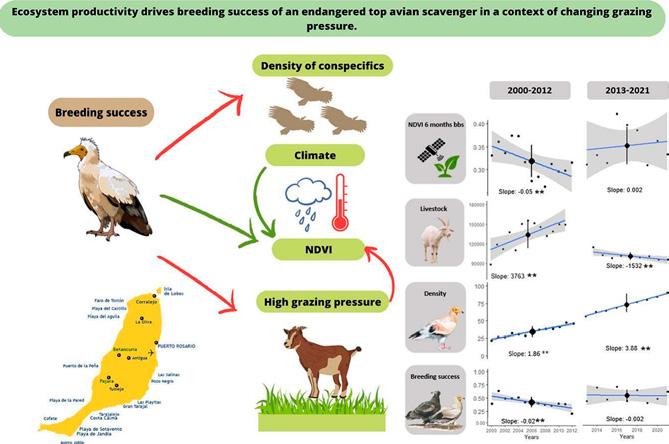
Since part of the diet of the guirre are vertebrates that take refuge and feed on that vegetation, when the grass is recovered, the bird has more food and reproduces more
since minimal changes in ecological conditions can have direct consequences in stages that are crucial for population development, such as reproduction. This work will allow the design of tools for dealing with and managing this subspecies, as well as the design of effective conservation strategies.
This study had the participation of the researcher of Applied Biology of the Institute for Agri-Food Research CIAGRO-UMH Lola Fernández Gómez, the researcher of Applied Biology of the UMH Jomar M. Barbosa, the professor of Ecology of the UMH José Antonio Sánchez Zapata, the researcher of Conservation Biology of EBD-CSIC José Antonio Donázar, as well as the researcher of Statistics of the Institute Centre for Operational Research ICIOUMH Xabier Barber.
The population of Fuerteventura’s Canary Island guirres is related to ecosystem dynamics. The more livestock, the less available vegetation. Therefore, the animals on which the scavenger feeds do not thrive, directly affecting their reproductive success.Illegal
Illegal hunting, power lines and cats are killing the marbled duck, a duck emblematic of the wetlands of southeast Spain and which is at risk of disappearing. A study carried out by a team of researchers from the University Miguel Hernández of Elche (UMH), the University of Alicante (UA) and IMEDEA – a joint centre of the CSIC and the University of the Balearic Islands – concludes that unless at least 40% of the unnatural mortality of this species is reduced, the recovery programmes for the marbled duck in Spain will fail.
According to the researchers, in Spain, a lot of media attention is paid to endangered species such as the Iberian lynx, the brown bear or the Spanish imperial eagle. However, the seven critically endangered species, that is, those with an imminent risk of disappearance, are much more unknown. These species include two birds, two mammals, one plant and two mollusks.
Among them is a duck: the marbled duck. This species, considered the most endangered duck in Europe, almost disappeared a decade ago, when only a few dozen breeding pairs were detected in the environment of Doñana and the wetlands of southern Alicante. To reverse this situation, both the Autonomous Communities and the central government undertook various conservation actions, including a recovery programme with the release of captive-bred birds. Thanks to this programme, more than three thousand individuals have been released in recent years, but despite this, the populations of marbled ducks are not growing as expected.
To evaluate the effectiveness of the recovery programme, researchers from the Ecology Area of the UMH, in collaboration with colleagues from the UA and IMEDEA-CSIC-UIB, have carried out a study that has enabled them to find out the survival of the individuals released in the Valencian Community, identify the main causes of mortality and finally assess the future viability of the species. For this, the data provided by sightings of ringed individuals have been key, as well as the data collected through GPS devices with which more than 40 birds have been equipped in recent years.
The study results indicate that mortality from unnatural causes, such as illegal hunting, power lines collisions or predation by cats, triples natural mortality. Illegal hunting, either by identification errors in legal hunting days or by poaching, stood out as the most significant cause of mortality for the species since it affected one in three GPS-tagged birds, both captive and wild-bred. To determine the causes of mortality, the use of GPS devices was crucial, as it enabled to accurately identify the place and day of death. Unfortunately, 50% of GPS devices unexpectedly stopped transmitting data. Researchers suspect that it could largely be due to illegal hunting, as 70% of these devices suddenly stopped working when the bird was inside a hunting reserve. In addition, the results warn that the presence of cats in wetlands (both domestic and feral) is an emerging threat that needs to be addressed carefully since cases of cat predation have been detected, which can lead to significant losses.
 Author: O. Aldeguer
Author: O. Aldeguer
“If the human-related mortality is not reduced, it will not be possible to recover a self-sustainable population, no matter how many specimens raised in captivity are released”
According to Juan Manuel Pérez García, a professor in the ecology area of the UMH, the high rates of unnatural mortality are compromising the recovery of this critically threatened species. “If the human-related mortality is not reduced, it will not be possible to recover a self-sustainable population, no matter how many specimens raised in captivity are released”, the expert points out. The analyses indicate that the unnatural mortality of these birds should be reduced by 40% to recover populations. To achieve this, the authors propose several urgent measures that include banning the hunting of waterbirds in hours with poor visibility to avoid confusion and accidental deaths of non-game species, increasing the prosecution of poaching, controlling exotic predators in wetlands, and improving water management to reduce outbreaks of diseases such as botulism.
The researchers also suggest that some improvements could be made to recovery programmes based on captive breeding and release. They suggest that delaying the release of captive-raised birds until the end of the hunting season could have long-term negative effects, increasing habituation to humans and reliance on predictable food sources. Finally, they propose recommendations to reduce the stay in captivity and provide anti-predatory training to the birds released in the breeding cages.
There are animals that adapt better to environmental changes and the key to this lies in their DNA and microbiome. A recent study, led by teams from the Institute for Animal Science and Technology of the Polytechnic University of Valencia (UPV) and the Institute for Agri-food and Agri-Environmental Research and Innovation (CIAGRO) of the University Miguel Hernández (UMH) of Elche, concludes that the immune system is influenced differently by the bacterial composition of each population. Researchers from the University of Lleida (UdL) have also participated in the work. Its results could improve animal welfare and the sustainability of the livestock sector.
The research is the first in the field of animal genetic improvement to have identified gut bacteria that may be influencing animals’ ability to adapt to environmental changes, that is, affecting their resilience. In addition, these bacteria, in turn, could be regulated by the genes of these animals. In this way, the results obtained by the UPV and UMH team could contribute to improving animal welfare and the sustainability of the livestock sector.
The immune system is key to responding against environmental threats, such as infection by external pathogens, as explained in the scientific work. The identification they have achieved of these bacterial species highlights the importance of the immune system in the regulation of resilience. They have identified genes and species that contribute to a better health of the individual, therefore, to a greater capacity for adaptation.
To reach these conclusions, the teams of the UPV, the UMH and the UdL compared the microbial composition of two lines of rabbits in the same environment, with a common genetic origin but divergently selected. The lines were selected divergently in the UMH for 13 generations, taking into account a specific phenotype: the environmental variance of litter size. The importance of this phenotype lies in its relationship with the ability of the animal to counteract or cope with environmental changes, without its production being harmed or recovering it in an optimal and rapid way. That is, it has been observed that animals with a lower environmental variance in their litter size are more resilient animals.
Using different bioinformatics tools, the UPV team analysed a representation of animals from both rabbit populations. Through various statistical methodologies, they identified several groups of bacteria and bacterial genes that enabled classifying and predicting which animal belonged to each population with a reliability greater than 90%. In total, 35 species of bacteria were identified. Although the effect caused by many of them is confusing or unknown, some of the identified ones regulate immune activity and could be affecting the health status of rabbits and therefore their resilience.
Among the groups of bacteria, the researchers explain, species beneficial to the health of the individual were observed in the more resilient animals – such as Limosilactobacillus fermentum and Odoribacter splanchnicus – while the most harmful species were detected with greater abundance in

The immune system is influenced differently by the bacterial composition of each animal population
the less resilient line (Eggerthella sp and Acetatifactor muris). The study has also identified microbial pathway genes that could help regulate the immune system.
All these results suggest that the immune system is influenced differently by the bacterial composition of each animal population. This work opens the door for the livestock sector to apply this knowledge in the future to study the composition of bacteria in their animals and select those most suitable to modulate resilience. A selection based on the microbiome could be made and, in addition, the benefits of developing probiotics based on these bacterial species could be studied to modify animal resilience in a simpler, cheaper and more applicable way on a large scale, the study concludes.
The work has been led by researchers from the Polytechnical University of Valencia (UPV), belonging to the Institute for Animal Science and Technology (ICTA), and researchers from UMH belonging to the Institute for Agri-food and Agri-Environmental Research and Innovation (CIAGRO) has verified how the immune system is influenced differently according to the bacterial composition of each animal. The results of this study, in which researchers from the University of Lleida (UdL) have also participated, have been published in the journal Microbiome.
Analysis of gut microbiome commissibility in rabbit populations. Source: Casto-Rebollo, C. et al., 2023, Microbiome.Three research projects search for effective strategies to preserve the quality of soils
The soil is home to life and sustains it. Millions of microorganisms live in it and, if this was not enough, it also enables the growth of crops that feed us and plants that provide oxygen. The soil transforms death into life. However, the disproportionate use of land makes it die gradually. Using this non-renewable resource sustainably is a responsibility of present generations toward future generations. Given the possibility of exhausting the regenerative capacity of the substrate, several projects of the University Miguel Hernández (UMH) of Elche propose solutions that enable to recover life on the earth – with lower case – at the same time that contribute to create a circular economic model of reuse of resources.
It may not seem as vital as the air we breathe or the water we use drink, wash or cook. However, the soil is one of the most important natural resources that enable life on Earth. It provides nutrients, water and minerals for plants and trees. It supports 90% of all food, fibre and fuel production and is home to billions of small animals, bacteria and microorganisms. In addition, it is a fundamental part of the nutrient cycle, due to its capacity to absorb and store carbon, nitrogen and phosphorus from organic matter. In addition, in the current climate crisis situation, as a global carbon sink, it plays an important role in possible ways to slow down global warming.
The soil is a non-renewable resource. It cannot be regenerated naturally as quickly as necessary to meet human consumption needs. With the number of activities that depend on it, managing it sustainably is important to increase its resilience. The decrease of organic matter, together with pollution and soil erosion, diminish its capacity to sustain the demands of society.
As an agricultural resource, the amount of fertile soil has declined at a rapid and steady rate. With a world population of eight billion people, farmers’ capacity to grow enough food is compromised. Moving circular economy to the countryside can be an option to increase the productivity of the agricultural sector in a sustainable way.
The Agrocompost project of the UMH and the Department of Agriculture, Rural Development, Climate Emergency and Ecological Transition of the Generalitat Valenciana aims to experiment with different types and methods of composting to discover the best mixtures for each farm. The initiative enables the production of high-quality compost with optimal ingredients according to the resources available in each place.
The farmers in the Agrocompost project compare the effectiveness of their own recipes with products from other commercial brands.
It all begins with the interest of the farmers who request the assistance of UMH researchers, who then visit the location and analyse the available organic material. Local agri-composting enables the generation of fertility in the cultivated field itself, recirculates the nutrients from the soil and prevents fires.
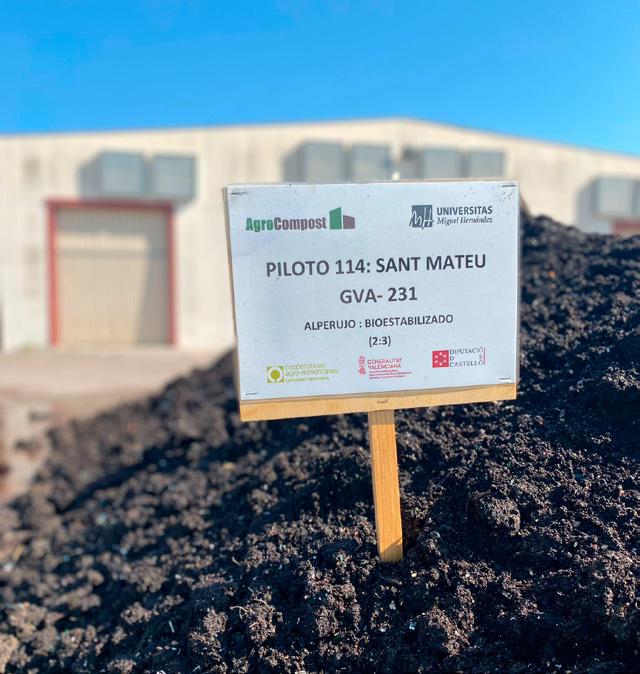
The soil is a non-renewable resource. It cannot be regenerated naturally as quickly as necessary to meet human consumption needs
While commercial fertilisers are used to optimise the production of intensive agriculture in the short term, this practice affects soil fertility and productivity in the long term. According to Professor of Edaphology and Agricultural Chemistry at UMH Raúl Moral, “industrial fertilisers have served, serve and will serve to feed humanity, but have a high energy cost in their production and transportation. In addition, its indiscriminate use leads the impacts on the hydrosphere, in the form of nitrates, and on the soil, as it produces salinisation, compaction, etc.”
The Agrocompost initiative has already 131 pilot farms in 125 municipalities throughout the Comunitat Valenciana. With the study of more than 270 composting processes with custom blends, the UMH researchers have managed to formulate and validate compositions adapted to the olive, wine, fruit and vegetable sectors.
In this same vein, the NEOCOMP project studies new ways of developing local composting at a mainly urban level using circular economy as a model. A practice that has been implemented in recent years and that has meant a change in the models of organic waste management that see as a resource what was previously considered just waste. Until now, the usual thing in waste processing, with the exception of some considered as high valuable, were the operations of “collection and disposal”. This results in the collection of mixed urban waste and its subsequent disposal, either in dumps or through incineration.
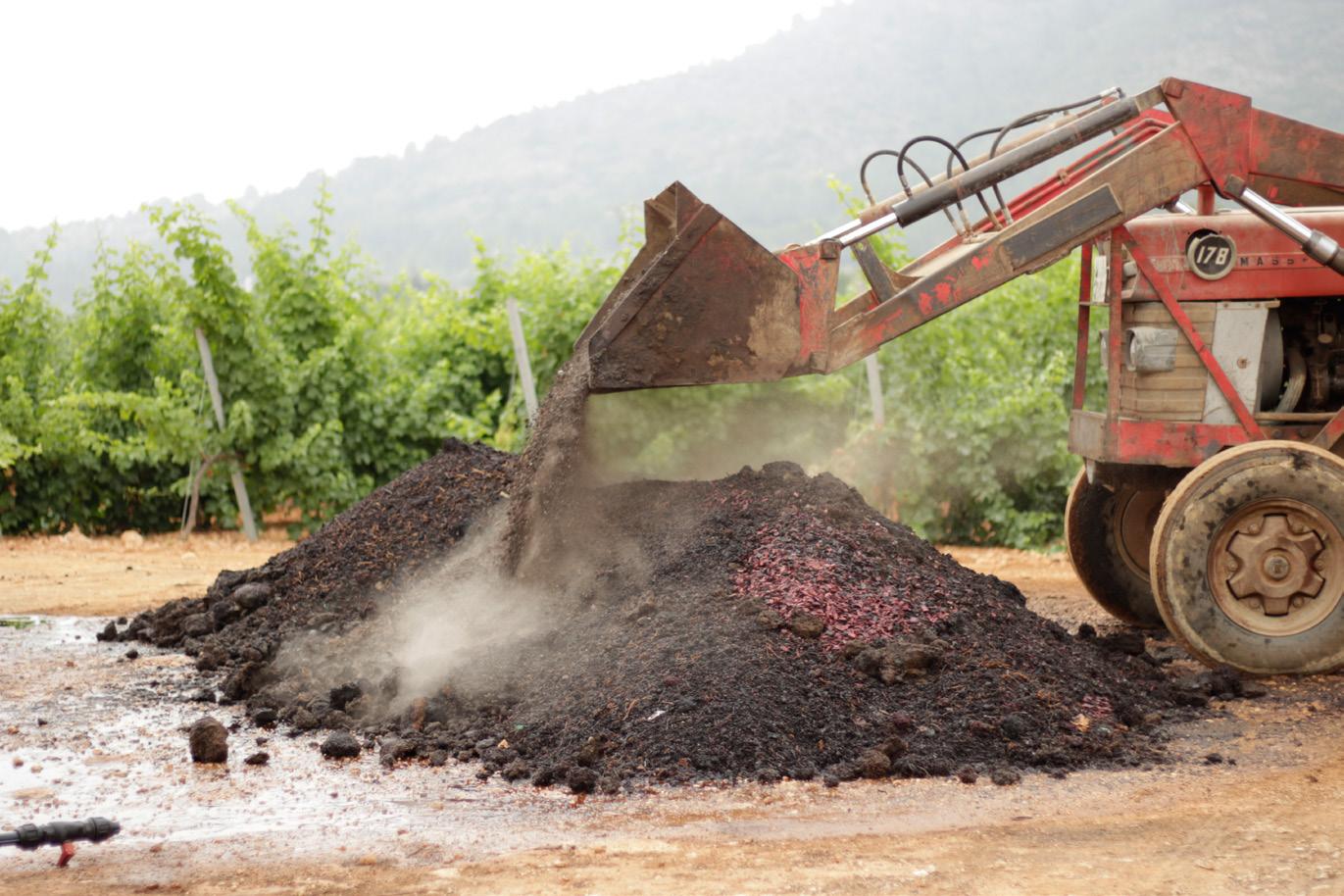
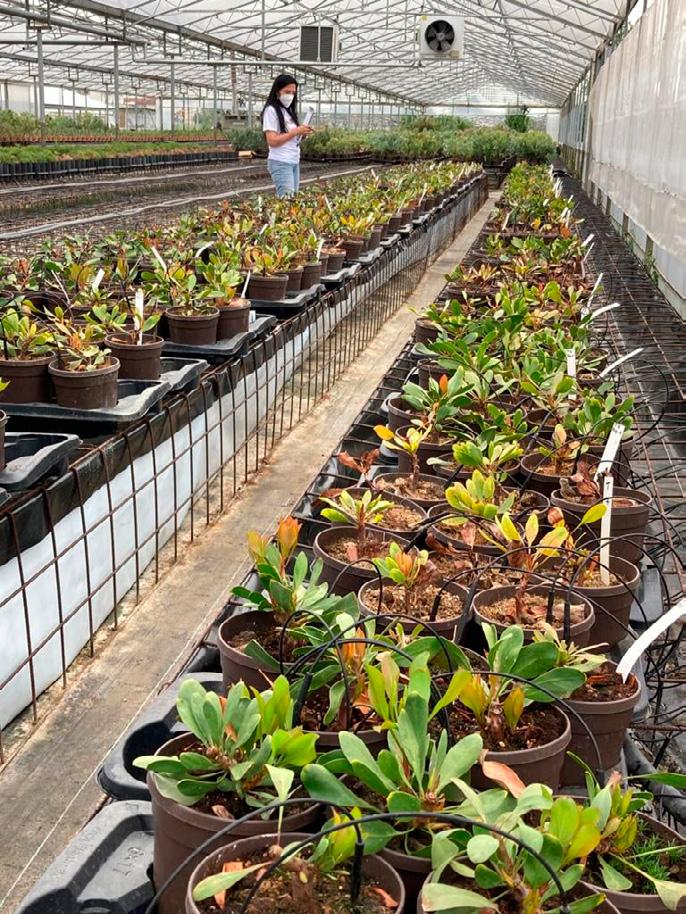
 01 (↑)
01 (↑)
The vision of NEOCOMP is precisely to go beyond a model that focuses on “cleaning up the mess” left by the products we use and that have reached the end of their life. The aim is to change the perception of ‘waste as a problem’ to ‘waste as a resource’. In this case, the use of circular economy in the production of compost from urban waste both enables reducing the environmental pollution that derives from open dumps and it is also an opportunity to recover essential nutrients for crop production, improve crop yield and reduce the use of chemical fertilisers.
Normally the flow of organic waste is processed in centralised composting facilities where the waste or materials arrive to create, after being processed, compost. However, there are certain sectors, such as rural or semi-rural areas, where the management of organic waste, especially domestic waste, is difficult, either due to its collection or transport. In this context, new decentralised composting scenarios appear, that is, local composting.
However, the final quality of compost depends on both the initial materials and the composting process developed. Compost made with uncontrolled materials and methods may have chemical characteristics that may pose a risk to health or the environment. The main objective of the NEOCOMP project, led by the professors of the UMH María Angeles Bustamante and María Dolores Pérez Murcia of the group for Applied Research in Agrochemistry and Environment (GIAAMA), is the monitoring and control of these new models of organic waste management, in addition to defining key indicators to be used in new regulations that guarantee the quality and safety of the compost obtained in these new decentralised local models. All this to be used safely in agriculture.
While European legislation is making progress on the reuse of domestic organic waste, other potential renewable resources still do not have a legal framework for recovery. For example, in Spain it is not allowed to use the organic matter of the seabed as agricultural fertiliser. However, an alternative to the problem of what to do with sediments that are routinely drained from ports would be to use them as natural fertiliser. Currently, the European Commission is studying its viability based on new scientific studies, among which is the LIFE Subsed project, in which the Institute for Agri-Food and Agri-Environmental Research and Innovation (CIAGRO-UMH) of the University Miguel Hernández participates. The aim of the initiative is to use sea sediments as organic fertiliser in the growth of citrus fruits and other fruit trees.
According to CIAGRO-UMH agronomist Pilar Legua, who leads the project in Spain, in addition to solving the problem of what to do with the sediments, using dredged-up sea material is an opportunity to lower farm activity with a new nutrient-rich material and without prejudice to health. However, in order to use these materials, it is necessary to process sediments in the same port with the use of herbaceous plants.
As a result of the studies carried out at the UMH, the researchers consider sea sediment a material of “high value”. They believe that it is a great alternative to commonly im-
There are certain sectors, such as rural or semi-rural areas, where the management of organic waste, especially domestic waste, is difficult
ported commercial fertilisers, which are expensive. On the one hand, for the price itself. On the other hand, due to the high environmental impact derived from pollution in the form of carbon dioxide that is emitted during transportation from their distant points of origin. Legua assures that using sea sediments extracted from ports gives “a use with commercial value to a waste that today generates an environmental problem to the ports and a great deal of expenses for its transport and deposit in the waste plants”.
In this initiative participate, in addition to CIAGRO-UMH, the plant nursery company Caliplant, from San Javier (Murcia), together with several technological institutes and companies in Italy. The project has studied how sediments behave in the trunk, leaves and fruits, and even the excess water from the drainage of trees. All this, in order to determine the hypothetical danger of this material from the seabed, without any contaminating consequences being detected.
The soil is much more than inert earth. It is a complex symbiotic system of organic matter, minerals, gases, liquids and living organisms that generate life. According to the United Nations, arable land is available only for the next sixty years. The good news is that the situation is still reversible and that science is doing its bit to remedy soil health.
Composting calculator: How to make your own compost?
This app, developed by the research and experimentation project in composting AgroCompost of the Generalitat Valenciana and the UMH, works as a calculator that helps to know the characteristics of compost that can be made from organic waste from the kitchen or the waste of pruning the garden.
sQaPP: what is the quality of the soil we walk on?
This app, developed by the European project ISQAPER and in which the Environmental Soil Science Laboratory GEAUMH participates, offers data on the characteristics of the soil in a given location, and offers suggestions to improve its quality.
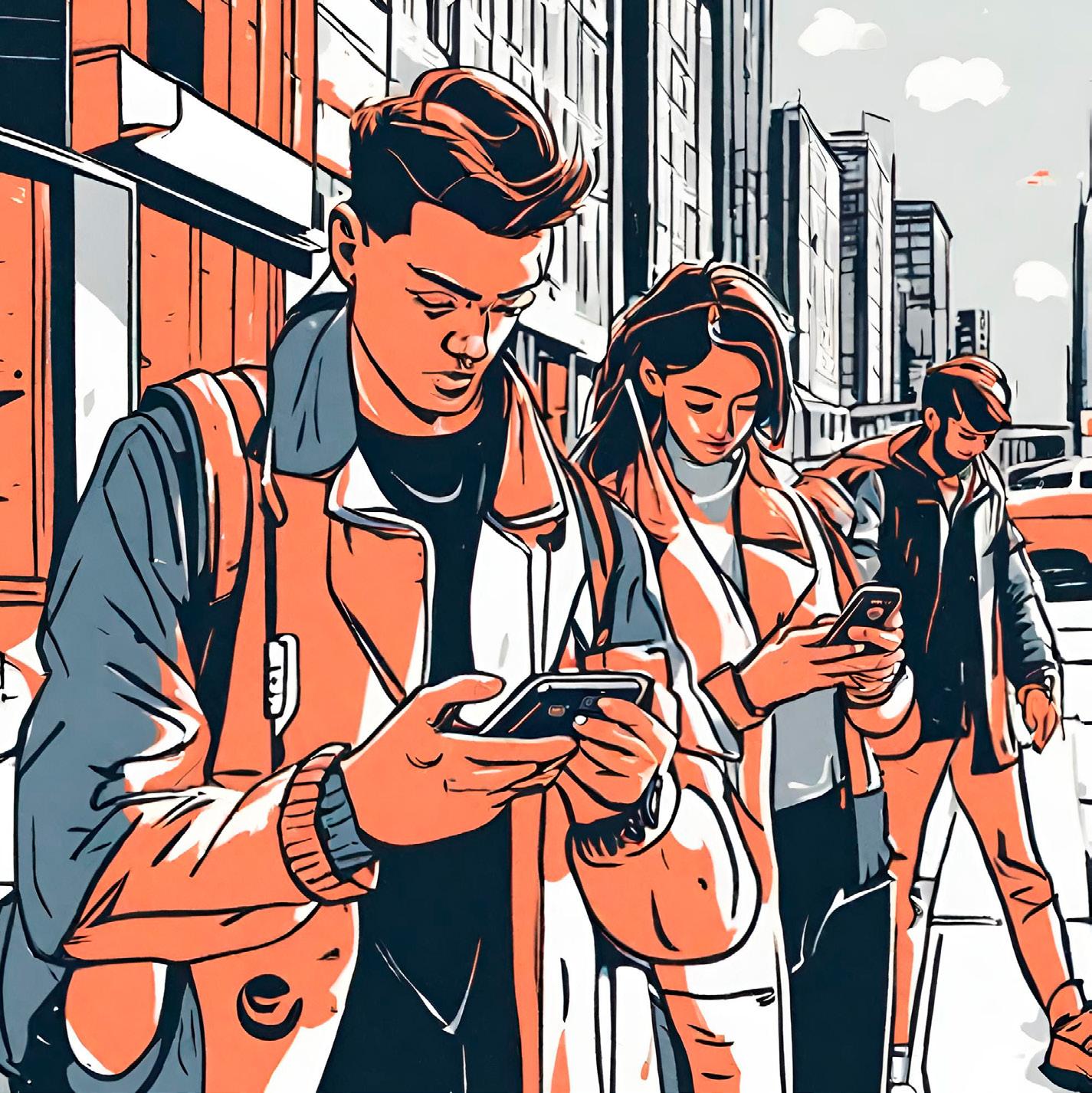
40 journalists, experts, and European media representatives convened at the Austrian Academy of Sciences to discuss innovation
Misinformation, Artificial Intelligence, and the rise of social networks are challenging journalism, which was already facing a tumultuous period due to the decline of print media, information overload, and a lack of appeal to younger audiences. As explained by Jose Alberto García-Avilés, a journalism professor at Miguel Hernández University (UMH) of Elche, the journalistic profession is undergoing a challenging phase where its traditional role as a watchdog is being questioned. However, at the same time, journalism remains an indispensable tool against misinformation and the manipulation of public opinion. Furthermore, innovation is becoming a crucial asset for media companies. García-Avilés is the principal investigator of the Spanish team in the project “Innovations in journalism in democratic societies: Index, influence, and prerequisites in international comparison”, which began in October 2020, with the participation of 19 researchers from Austria, Germany, Spain, Switzerland, and the United Kingdom.
Many media outlets are undergoing a disruptive transformation, with some discovering innovative approaches to sustain the profession. Other media companies have managed to survive the impacts of digitalisation and globalisation, as well as the revolution brought about by the COVID-19 pandemic that accelerated digital transformation. “We focus on a special and significant research area: journalism as the backbone of democracy,” underlines García-Avilés. The project adopted a multiple case study design to identify the most important journalism innovations in the past decade. It explored the relevance and purpose of journalism through a hundred interviews with experts structured for international comparability. Textual analysis was employed to code and analyse the interviews, clustering the results into the main forms of innovations that were compared across five countries.
In each country, the researchers compiled a list of the top 20 innovations in four areas of media: product, organisation, distribution, and commercialisation. Many of these, such as content automation, new digital narratives, or data journalism, require technological competence in usingtools and developing new products that add value to users and the news organisation, ultimately benefiting from their implementation. The researchers emphasise that innovations must successfully increase audience, revenue, organisational improvement, brand image, or prestige for the news organisation. These goals are evident in innovations related to cultural organisations, collaborative journalism, or projects on new business models.
García-Avilés explains that the process involved in each innovation includes design, experimentation, testing, development, dissemination, and learning. Of course, tools and technologies play a fundamental role, but also management and leadership skills, professional culture, and talent. García Avilés argues that “the ‘human factor’ is essential, as innovation cannot be thought of in economic terms alone.” “Innovation does not necessarily come from business or technology, but rather from being able to create something unique that ultimately arises from a series of inspirations and contributes to solving people’s needs”, says García-Avilés.
The researchers highlight the ethical implications of journalism. As the principal investigator emphasises, in a highly tech-
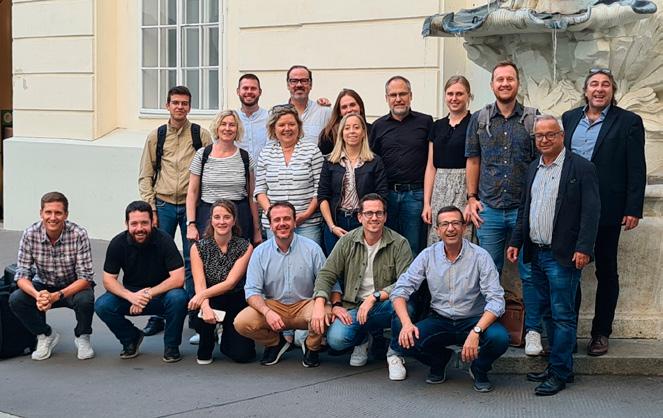
The project adopted a multiple case study design to identify the most important journalism innovations in the past decade
nological environment, it is necessary to consider the ethical challenges generated by using Big Data and Artificial Intelligence, such as misinformation and political bias. The thoughtless use of data to guide journalistic decisions can increase inequality, fake news, all kinds of bias, and a lack of representation of minorities. Academic and professional experts advocate for developing data-informed processes that incorporate human knowledge and promote an open media culture. This approach, they say, would support a rigorous analysis of information and a better-educated society.
The research team also designed practical recommendations for journalists, media managers and policymakers so they can improve the quality and the democratic function of journalism. In order to share the results of the project, an international conference with 40 experts from media companies and institutions from the five countries was organised at the Austrian Academy of Sciences in Vienna in September 2023. As García-Avilés remarks, “In the face of Artificial Intelligence, the differential value of journalists will be their creativity, their ability to connect with people and to ask good questions because we are now going to have a much more homogeneous journalism, designed by machines that often tells us nothing”.
The project was carried out as a so-called D-A-CH cooperation among the Catholic University of Eichstätt (Germany), the Medienhaus Wien Research Association, the Austrian Academy of Sciences, and the University of Klagenfurt (Austria), the Zurich University of Applied Sciences with partners at the University of Lugano (Switzerland), the City University in London and, of course, the Miguel Hernández University. Funding was provided by national basic research institutions of the D-A-CH countries: The German Research Foundation (DFG) project no. 438677067 and 512640851; The Austrian Science Fund (FWF) project no. I 4797-G; and The Swiss National Science Foundation (SNF) project no. 100019E_190126.
The challenges related to motherhood often lead women to leave the academia after their first child. In fact, studies in the United States suggest that about 50% of female scientists in this country leave science after motherhood. To address this problem, a group of female scientists and mothers, among which is researcher of Ecology of the University Miguel Hernández de Elche (UMH) Eva Graciá, propose ten urgent measures that academic institutions should take to create a friendlier environment and thus prevent women from leaving their academic careers after childbirth.
These guidelines cover several aspects, from support during pregnancy to work-life balance or career development opportunities. They include measures such as support during pregnancy, childcare and breastfeeding and the school phase, actions aimed at organising, making flexible and distributing research and teaching activities equitably, and measures for the professional development of mothers, thus fighting mental health problems, discrimination and harassment.
This paper, published in the journal PLOS Computational Biology with the title ‘Ten simple rules for a mom-friendly Academia’, highlights the need for greater representation of women in science, including mothers, because equality is a fundamental right and, in addition, there are papers proving that diverse work environments are more productive and innovative.
The article, led by Esther Sebastián-González, researcher of the Department of Ecology of the University of Alicante (UA), has Eva Graciá, researcher of the Department of Applied Biology of the UMH, researcher at CREAF-Centre for Ecological Research and Forest Applications of the Autonomous University of Barcelona (UAB) Alejandra Morán-Ordóñez, researcher at the Agri-Food Institute of Aragón of the University of Zaragoza (IA2-UNIZAR) Irene Pérez-Ibarra, researcher at the Department of Ecology and Evolution of the Mediterranean Institute for Advanced Studies – a joint centre of the CSIC and the University of the Balearic Islands (UIB) – Ana Sanz-Aguilar, and researcher at CRETUS-Interdisciplinary Centre for Research in Environmental Technologies of the University of Santiago de Compostela (USC) Mar Sobral.
According to the signers of the decalogue, the benefit of implementing many of these ideas will be for trans mothers and fathers as well as for fathers, caregivers of dependent people, women and even the academic community in general. It is imperative that academic institutions take proactive steps to promote gender equality and empower all people, including mothers, in the development of their scientific careers.
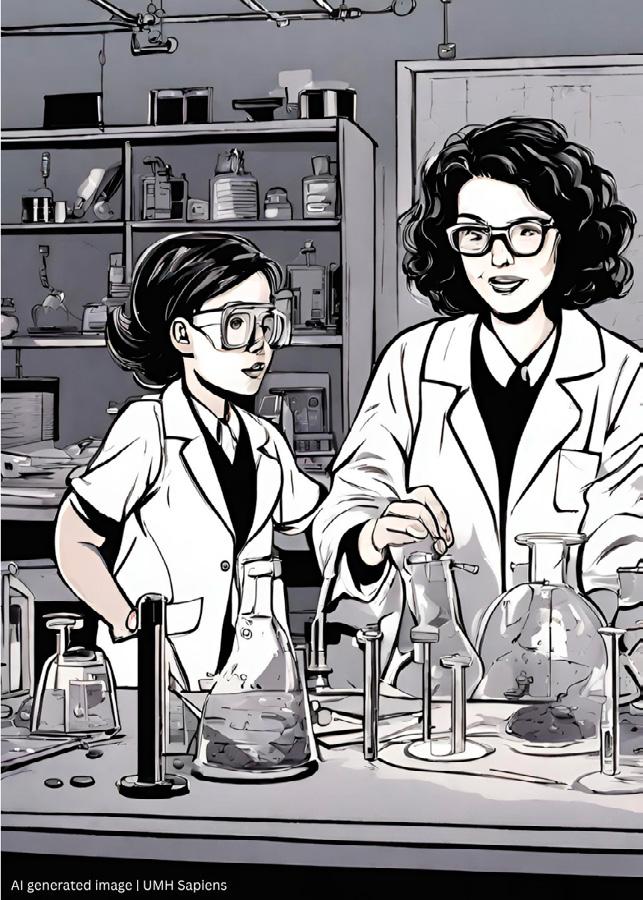
Among the measures proposed by this group of scientists is the technical support to pregnant women for field and laboratory work, as well as policies to facilitate flexible working hours and remote work. Another point that the article highlights is that maternal and paternal leave shall be taken into account in selection processes and eligibility criteria for scholarships and research positions. They also call for the establishment of day-care centres and nursing centres at work and in scientific meetings, flexibility in working hours and location, and prioritising parents with children in selecting teaching hours during school hours.
To support the professional development of mothers, the authors include other issues such as being able to extend at least 18 months per child the eligibility window for scholarships and grants for scientific mothers, waiving the geographical mobility requirement in scholarships and grants for scientific mothers, and creating specific grants after long career breaks. They also propose to create, disseminate and enforce anti-harassment and anti-discrimination policies in all research institutions, and reduce unpaid and unrecognised work of women, such as being members of recruitment or thesis committees, and equating this administrative burden to that of men.
The following is a description of the ten measures included in the article:
Institutions should provide comprehensive support systems, including resources, guidance and adjustments, to help women during the pregnancy process. This support should go beyond physical considerations and also address emotional and professional aspects.
To promote the implementation of paid parental leave that is flexible and respects individual choices. These policies should also foster a culture of inclusion and support for all caregivers.
Establishing child-care facilities and spaces for breastfeeding or expressing breast milk allows mothers to continue their academic work while caring for their children. These facilities shall be easily accessible, promoting a perfect integration between work and family life.
Whenever possible, department meetings or activities should be held during school hours to facilitate attendance to parents. Allowing online participation in seminars and meetings is also a way to help work-family balance.
Providing flexibility in working hours allows for effective management of professional and personal responsibilities. This flexibility may include remote work options, part-time arrangements, or adjustable schedules to suit the diverse needs of working parents.
Adapting teaching practices to support parents with young children promotes inclusion and ensures that mothers can actively participate in their academic commitments. Providing alternative teaching assignments, recorded lectures, or asynchronous learning opportunities benefits both mothers and other students with diverse responsibilities.
These guidelines cover several aspects, from support during pregnancy to work-life balance or career development opportunities
The implementation of positive actions to support mothers’ academic careers is crucial to address the professional disadvantages associated with motherhood. This may include mentoring programmes, funding opportunities, and extension tenure policies designed specifically to support and retain talented women in academia.
Establishing comprehensive mental health programmes and resources is essential to addressing the unique challenges faced by academic mothers. Providing access to counselling services, stress-management workshops and work-life balance initiatives promotes the overall well-being of mothers in academia.
Disseminating and enforcing anti-discrimination and anti-harassment protocols is crucial to creating a safe and inclusive environment for all researchers. Academic institutions should actively promote a culture of respect, equality and zero tolerance for any form of discrimination or prejudice based on gender or motherhood.
Ensuring a fair distribution of workload and responsibilities avoids overburdening women and promotes equal opportunities for career development. Academic institutions shall strive for transparency and fairness in the assignment of tasks and ensure that workload is balanced among all researchers.

43 umh scientists among worLd’s top-cited
43 umh scientists among worLd’s top-cited*
*According to a study by the Elsevier academic publisher on the Scopus scientific database.